Walk-in showers have evolved into design focal points, thanks in large part to the endless tile options available today. From timeless classics like crisp white subway tile to oversized porcelain slabs that minimize grout lines, there’s a tile solution to match every aesthetic and practical need. Home experts at HGTV and Better Homes & Gardens showcase a spectrum of ideas—from marble-clad walls that emulate luxury spas to 61 inspiring combinations that prove even the smallest spaces can feel expansive. In the following sections, you’ll discover 20 distinctive tile concepts—each with its own texture, pattern, and mood—to transform your walk-in shower into a personalized retreat.
1. Classic White Subway Tile
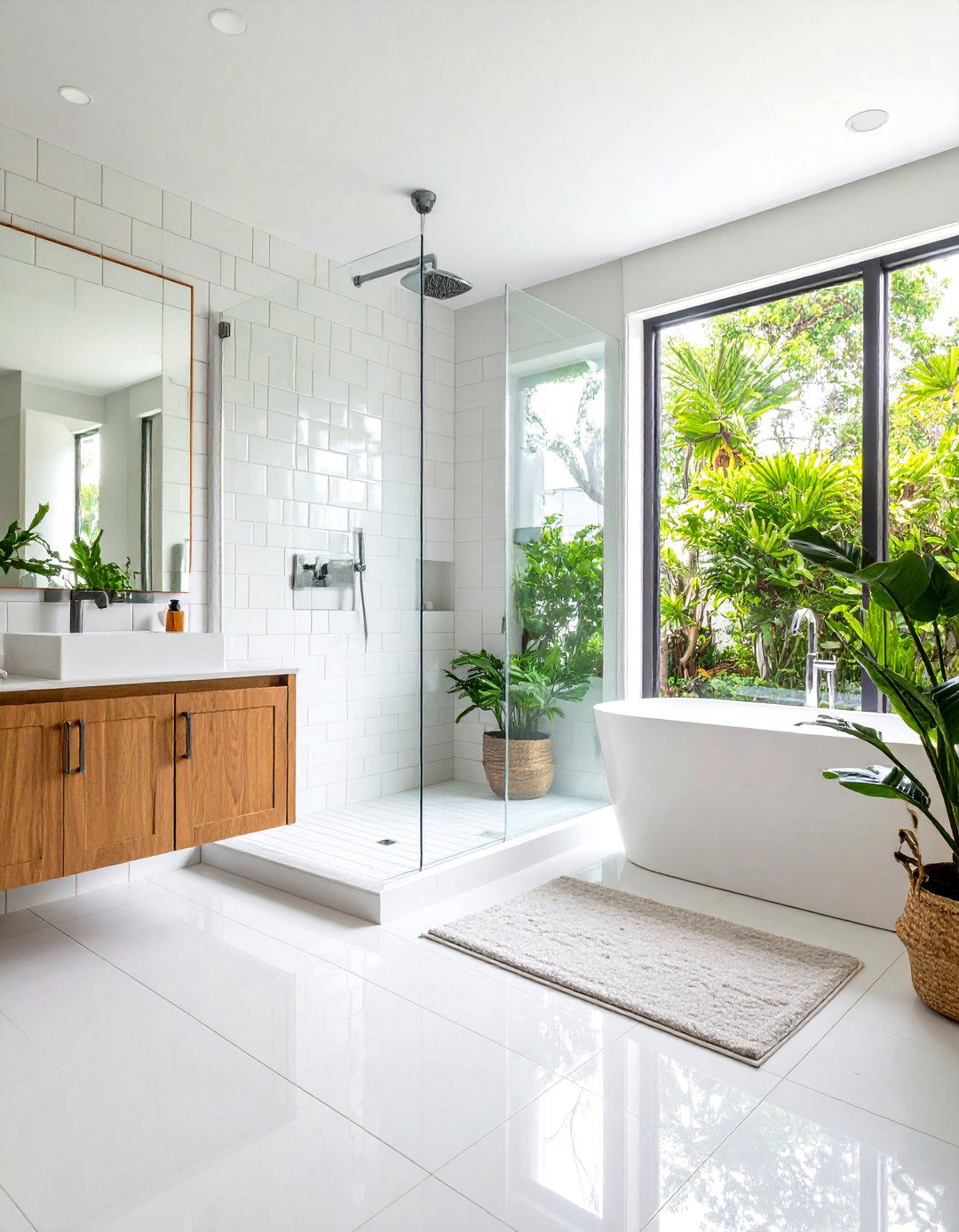
Covering the walls of a walk-in shower with white subway tiles and matching grout creates a clean, timeless backdrop that complements virtually any fixture or accent color. Laid in a traditional running bond, subway tile’s straight-edged simplicity reflects light off the glossy surface, making the shower feel larger and brighter. Beyond its aesthetic appeal, subway tile is practical: its standard 3x6-inch size keeps installation straightforward and maintenance minimal. To modernize this classic look, consider subtle variations in tile finish—such as matte or beveled edges—or introduce a soft-colored grout for a tone-on-tone effect that retains the design’s understated elegance.
2. Large-Format Porcelain Tiles
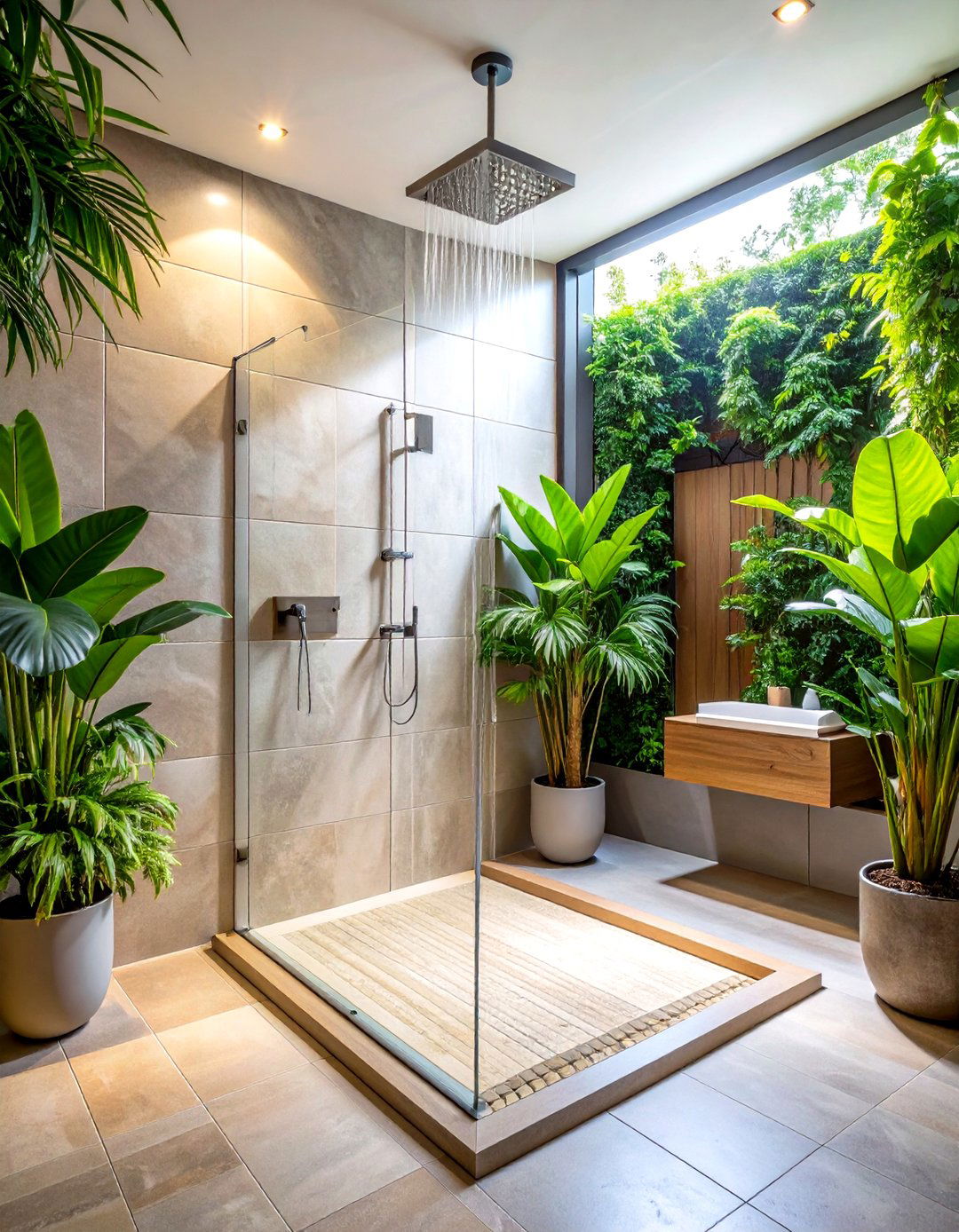
Opting for large-format porcelain tiles—often measuring 12x24 inches or larger—minimizes grout lines and delivers a sleek, seamless appearance that modernizes any walk-in shower. These oversized tiles have fewer joints, reducing care and cleaning time, and their uniform surface creates a minimalist aesthetic. Available in myriad finishes, from matte concrete looks to polished marble reproductions, large-format porcelain can mimic high-end materials without the weight or price tag of natural stone. For the smoothest finish, match the grout color to the tile; this continuity enhances the visual flow and reinforces the illusion of an expansive, uninterrupted plane.
3. Marble Slab Walls

Stalls lined in richly veined marble introduce a sense of grandeur and enduring elegance to walk-in showers. Full-height marble slabs eliminate repetitive tile patterns, offering a continuous surface where dramatic veining becomes the room’s primary feature. While natural marble requires sealing to protect against moisture and stains, many modern porcelain slabs faithfully reproduce its look with increased durability and reduced upkeep. To accentuate the stone’s natural beauty, pair marble walls with minimalist fixtures—think brass or matte black hardware—to create a high-contrast, contemporary-meets-classic environment that feels both luxurious and inviting.
4. Mosaic Accent Wall
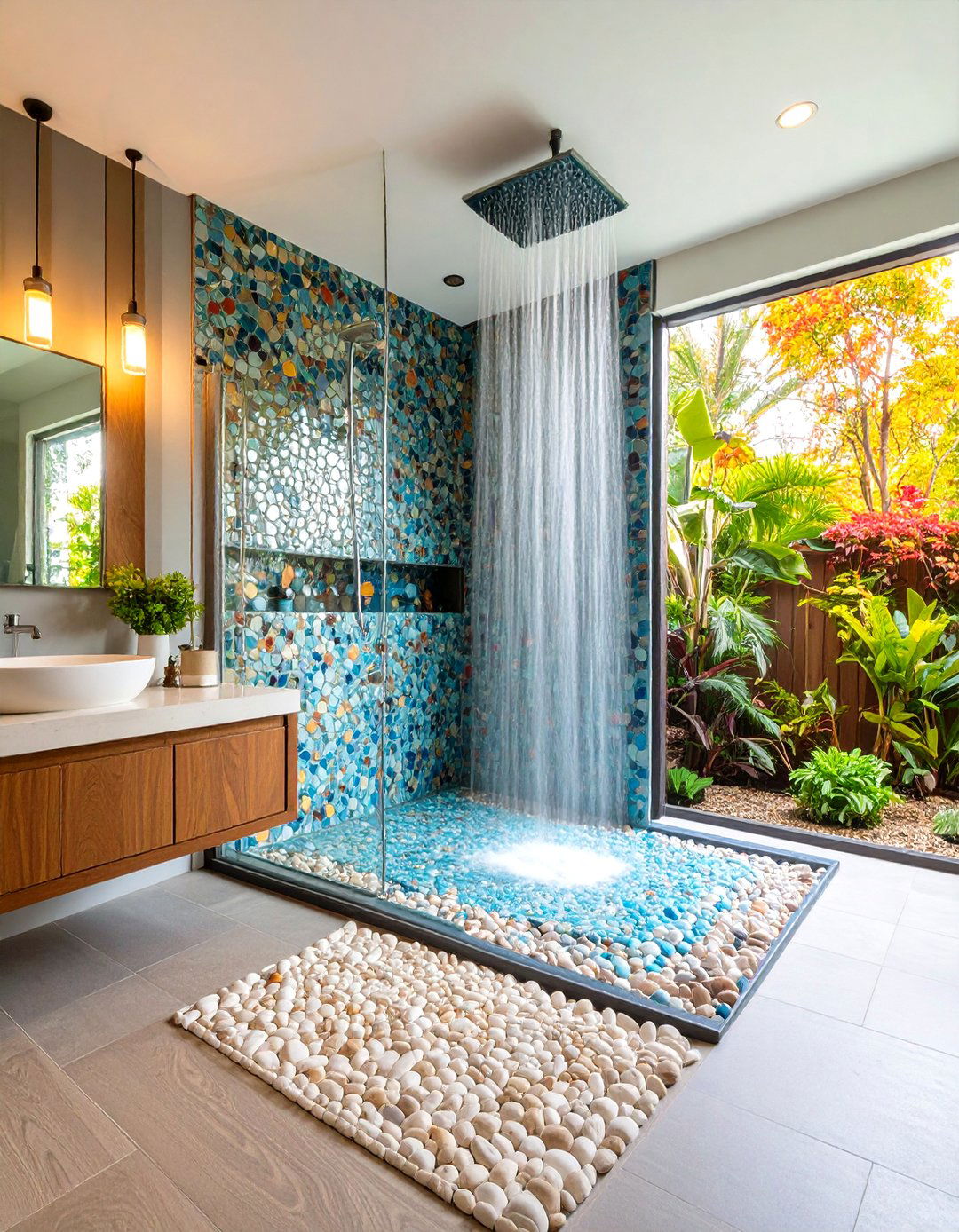
A mosaic tile accent wall serves as a striking focal point, using thousands of small pieces—often glass, ceramic, or natural stone—to create visual texture and color variation. Whether you choose iridescent glass penny rounds, irregular tumbled marble mosaics, or porcelain tesserae, a mosaic installation can frame niches, define plumbing fixtures, or highlight a built-in bench. For a cohesive design, select mosaic hues that echo the shower’s primary tile but introduce a complementary shade or sheen. Mosaic installations require more diligent grout sealing, but the dramatic interplay of light and pattern effortlessly elevates a standard shower into a bespoke retreat.
5. Herringbone Pattern Tiles

Herringbone layouts arrange rectangular tiles in a zigzag formation, adding dynamic movement and the illusion of expanded space to shower walls and floors. Whether executed with 2x6 porcelain planks or larger 3x12 sizes, herringbone’s angled pattern lends sophistication and depth. A 45-degree orientation projects energy, while a 90-degree setup aligns tiles squarely against the ceiling and floor for a more structured look. Contrasting grout can further highlight the pattern, turning functional joints into graphic lines. Ideal for accent stripes, full-wall installations, or even shower floors where traction is important, herringbone’s timeless appeal suits both traditional and modern interiors.
6. Bold Geometric Hexagon Tiles
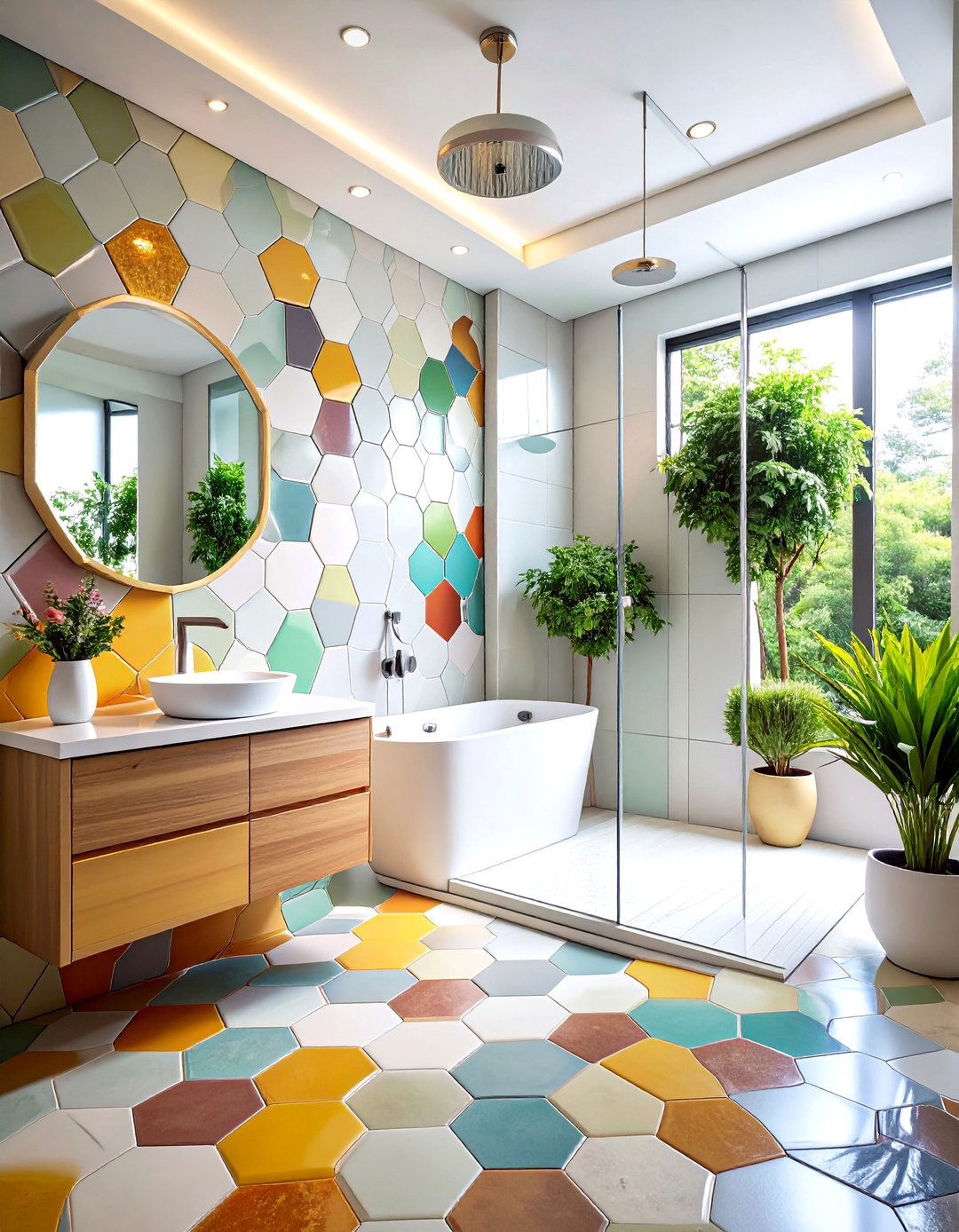
Hexagon-shaped tiles, available from tiny penny-sized pieces to one-foot-wide formats, create a bold geometric statement that modernizes walk-in showers. When laid in a honeycomb configuration, hexagons offer visual interest without overwhelming the senses. Opt for a single hue for a sleek, contemporary look, or mix two tones to generate subtle gradients or mosaic-like effects. Hex tiles also work well on shower floors, where their additional grout lines enhance slip resistance. For a truly standout feature, use hexagons as a vertical accent band or niche backdrop, framed by larger-format tiles on the surrounding walls.
7. Glass Tiles
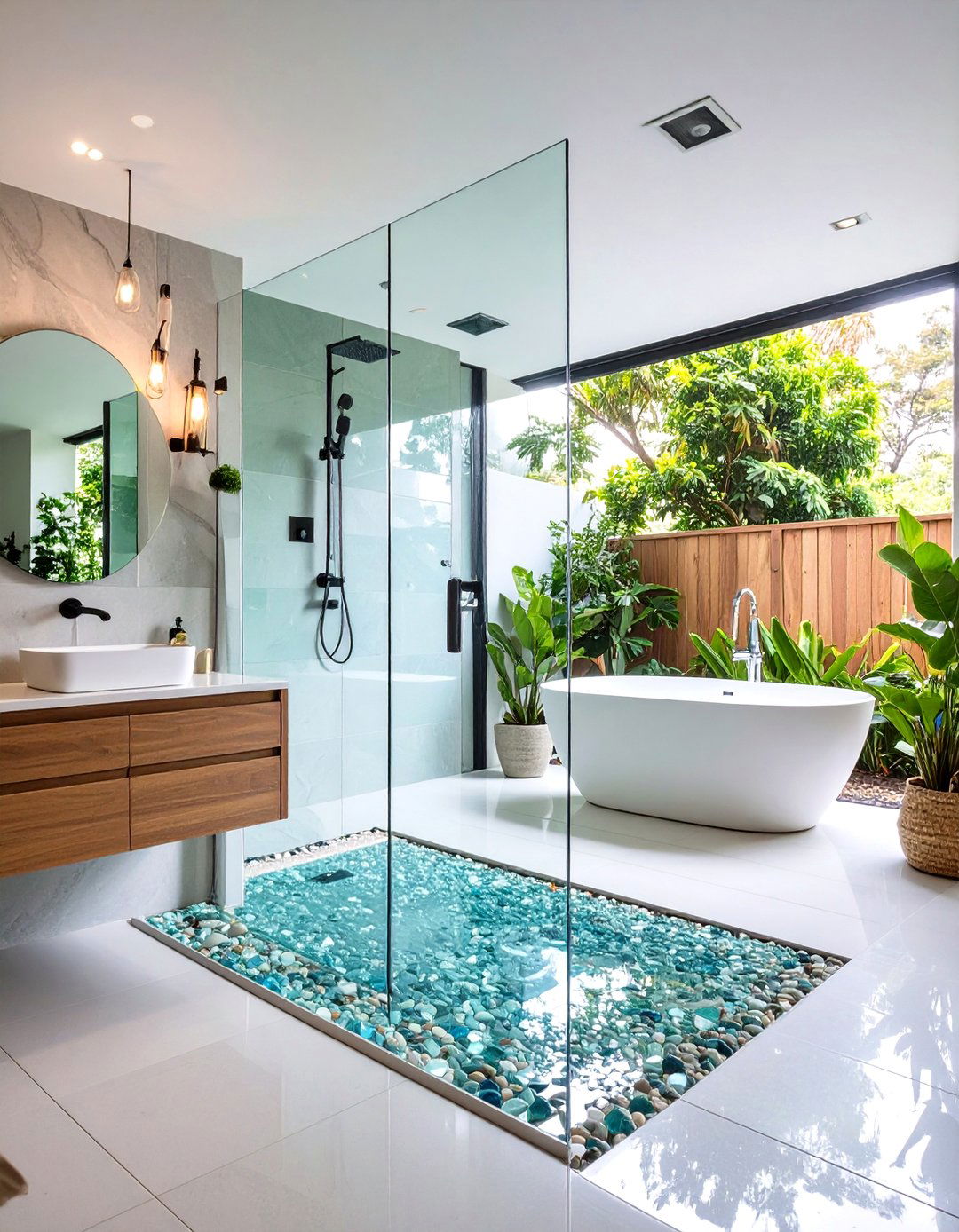
Glass tile introduces a lustrous, light-reflective surface that brings luminosity to walk-in showers. Available in subway, mosaic, and sculpted formats, glass tiles can showcase translucent blues, greens, or neutrals, adding depth and a sense of spaciousness. Their impermeable nature resists mold and mildew, making them ideal for wet environments. Consider using glass tiles to line the entire stall or as a bright accent strip against matte stone tiles. The reflective qualities enhance both natural and artificial lighting, resulting in a vibrant, jewel-like shimmer that elevates even compact shower enclosures.
8. Matte Black Hexagon Tiles
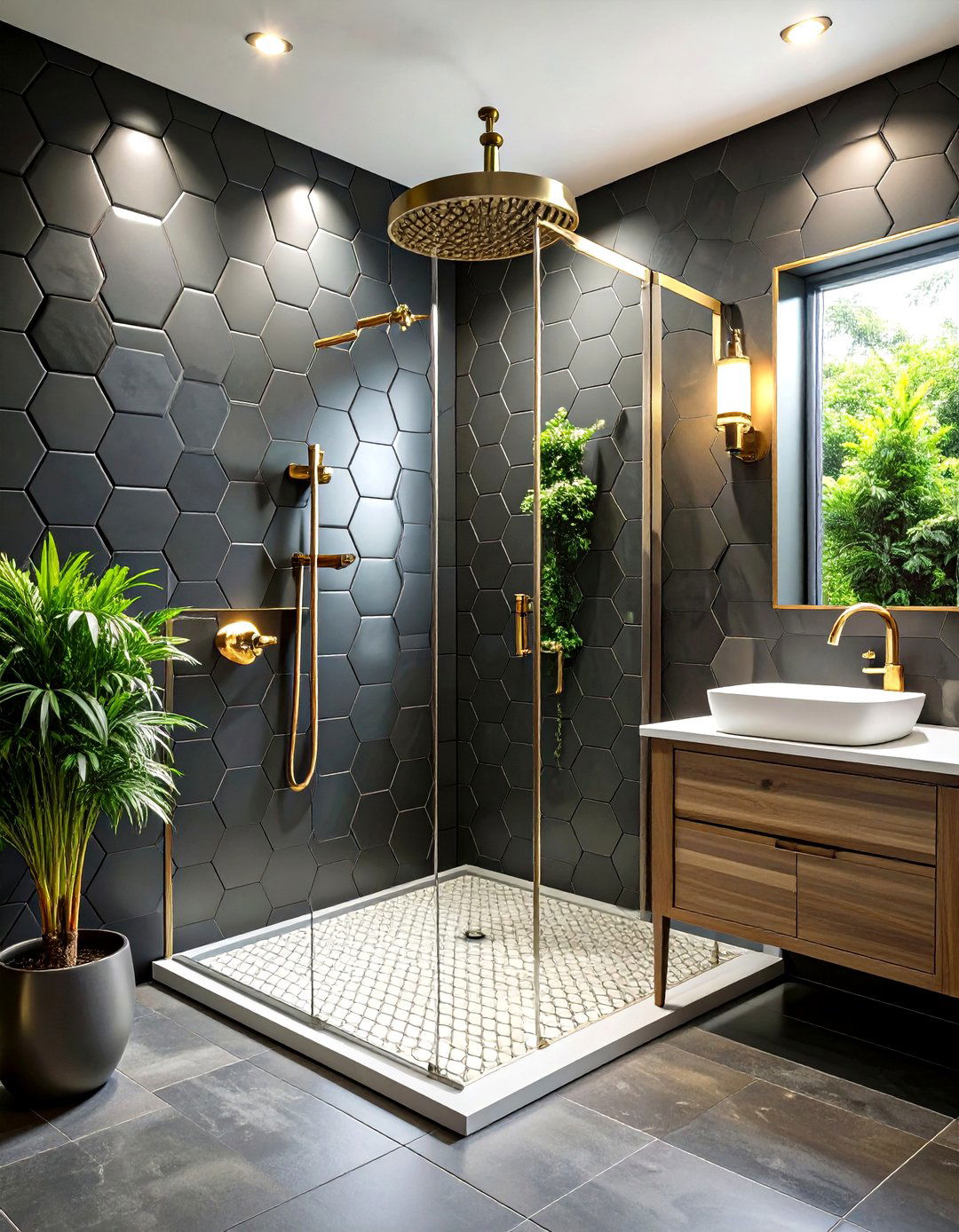
Matte black hexagon tiles lend a moody, contemporary edge to walk-in showers while emphasizing geometric form. When paired with white or light-colored surroundings, the dark hue draws the eye and creates graphic contrast. Matte finishes diffuse light, preventing glare and lending a soft, velvety texture underfoot or on walls. For balance, introduce metallic fixtures—brass or chrome—for a subtle sparkle, and maintain a minimal grout color to keep the joints inconspicuous. Black hexagons also integrate seamlessly into monochromatic schemes, supporting a spa-like retreat that feels modern yet grounded.
9. Moroccan Zellige Tiles
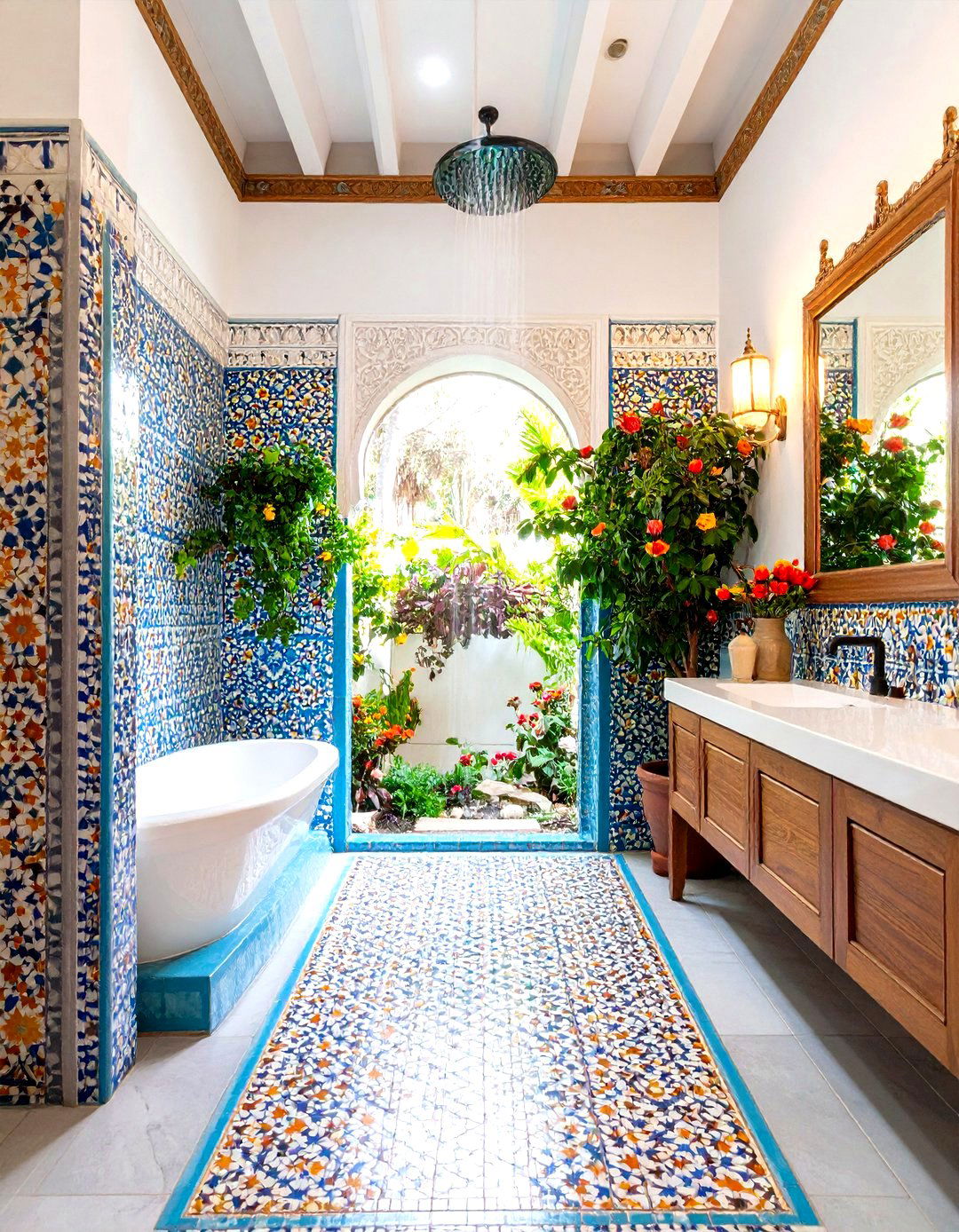
Handcrafted Moroccan zellige tiles boast irregular edges and distinctive glaze variations, imbuing walk-in showers with artisanal character and depth. These clay tiles—often 4x4 inches or smaller—reflect centuries-old craftsmanship, where each piece is unique. Zellige surfaces shimmer with color nuance, making them perfect for feature walls or full enclosures. Installing zellige requires skilled setters to accommodate the tiles’ slight irregularities and ensure watertight seams. To showcase the tiles’ warmth and texture, complement them with natural materials—such as unfinished wood benches or linen shower curtains—and matte black or brass fixtures that honor their handcrafted charm.
10. Penny Round Tiles
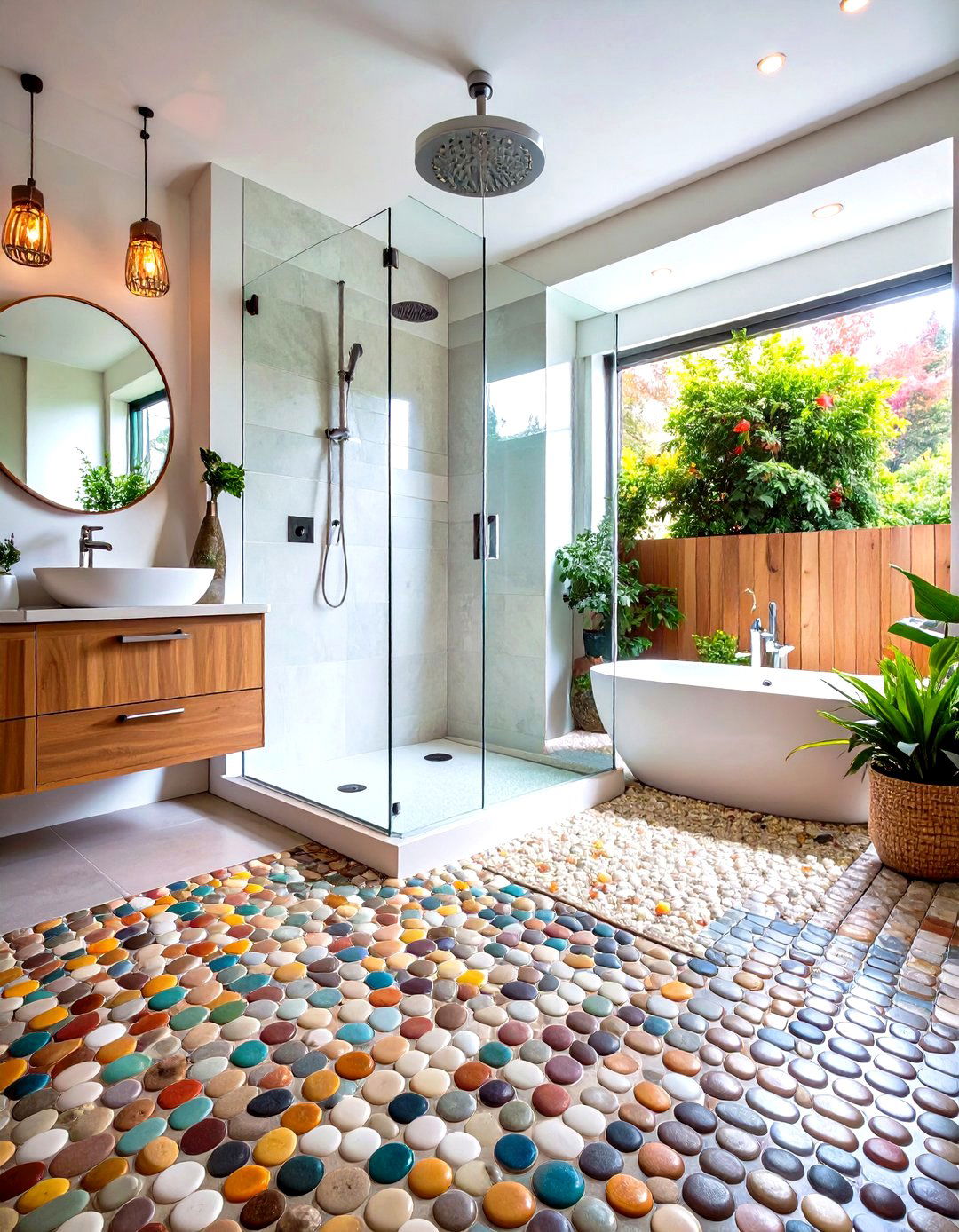
Penny round tiles, with their small, circular shape, introduce playful texture and tactile grip—ideal for both floors and walls in walk-in showers. Originally crafted from porcelain or ceramic, these penny-sized rounds now come in glass and metal variants. On shower floors, their multitude of grout lines enhances slip resistance, while on walls, they form a continuous, visually engaging surface. Classic all-white installations feel vintage yet timeless, or you can intermix colors for a confetti-like effect. Due to their small size, installing penny rounds demands patience, but the resulting mosaic is a bespoke, artful backdrop that stands apart.
11. Wood-Look Porcelain Tiles
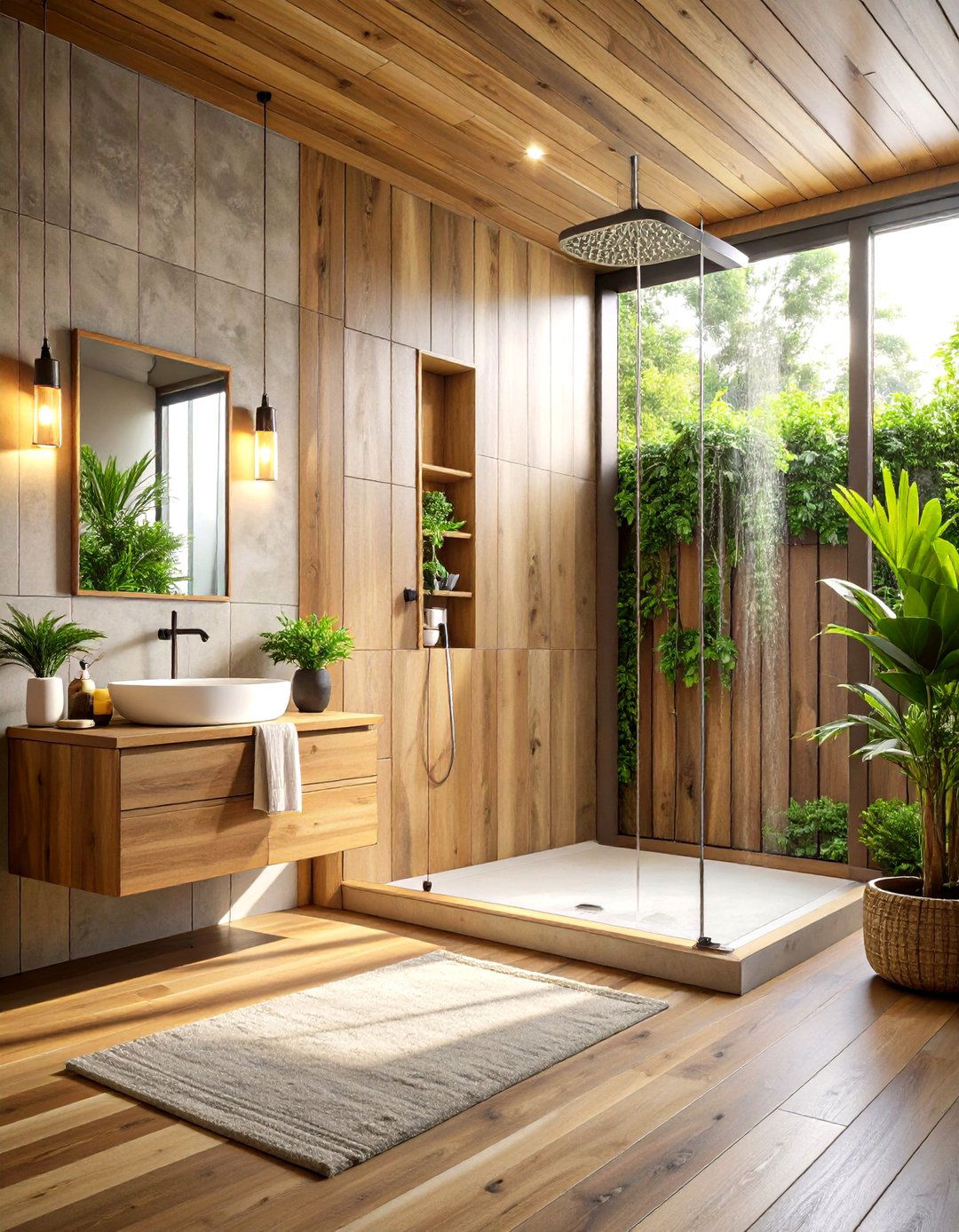
Porcelain planks mimicking natural wood grain deliver the rustic appeal of timber flooring with the water resistance porcelain requires for showers. Available in a range of wood species, from weathered oak to teak, these tiles bring warmth and organic texture to modern baths. Laid in plank formats—straight, staggered, or herringbone—they blur the line between indoor and outdoor styling. Porcelain’s durability and easy maintenance ensure that the shower remains pristine, while the realistic embossing and printed grain patterns convincingly replicate wood’s character. Pair with neutral grout to let the grain read clearly, and consider pairing with matte black fixtures for striking contrast.
12. Terrazzo Tiles
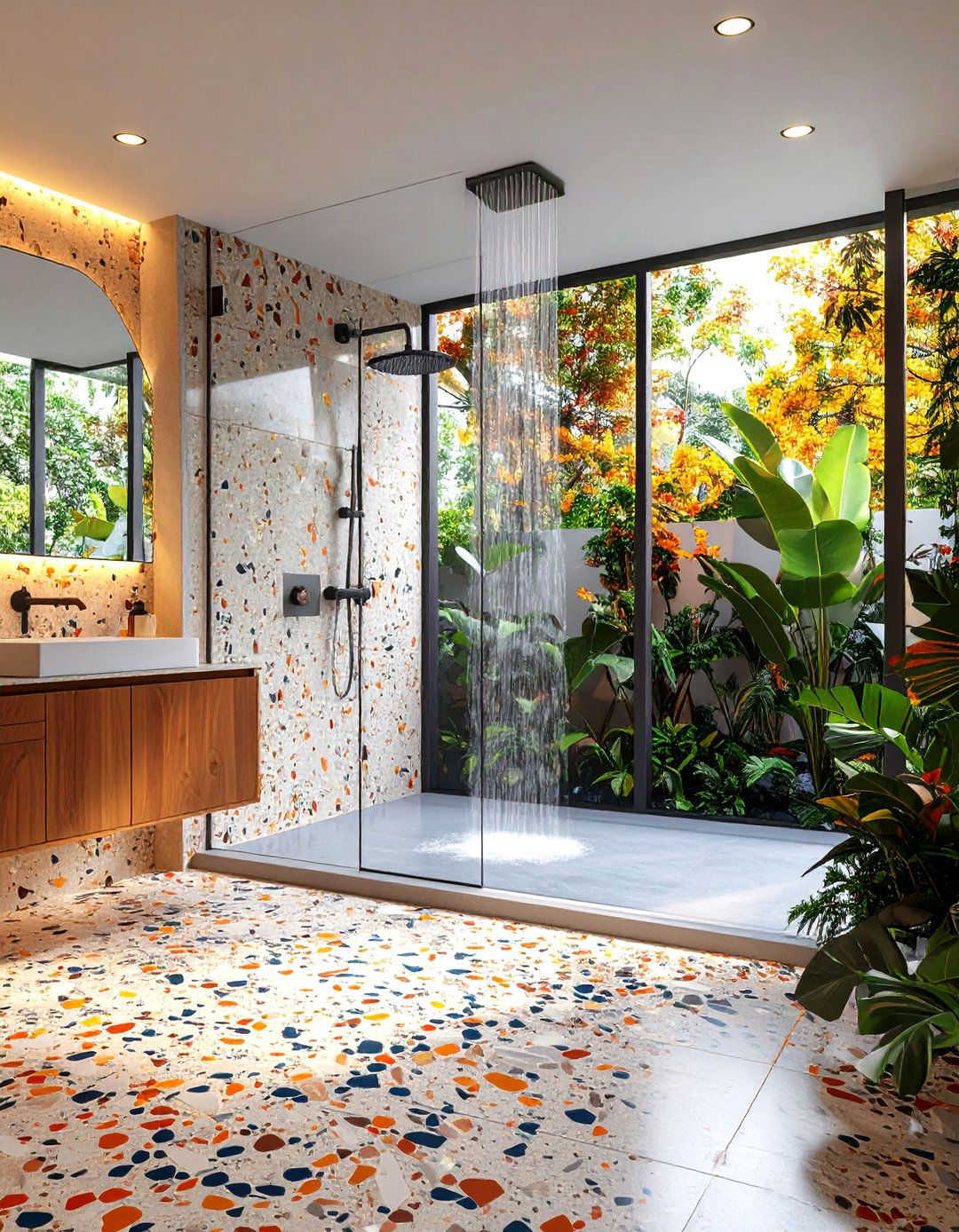
Terrazzo tiles, composed of marble, quartz, or granite chips in cement or resin binders, create a lively speckled surface that’s both durable and visually dynamic. Their aggregate flecks can range from subtle and tonal to bold and colorful, enabling endless customization. Terrazzo’s smooth, seamless finish lends a midcentury-modern flair, and when used on both walls and floors, it transforms showers into gallery-like spaces. For slip resistance, select matte or honed finishes. Because terrazzo is sturdy and water-resistant, it requires minimal sealing, making it a practical yet sophisticated choice for a long-lasting, statement-making walk-in shower.
13. 3D Textured Tiles
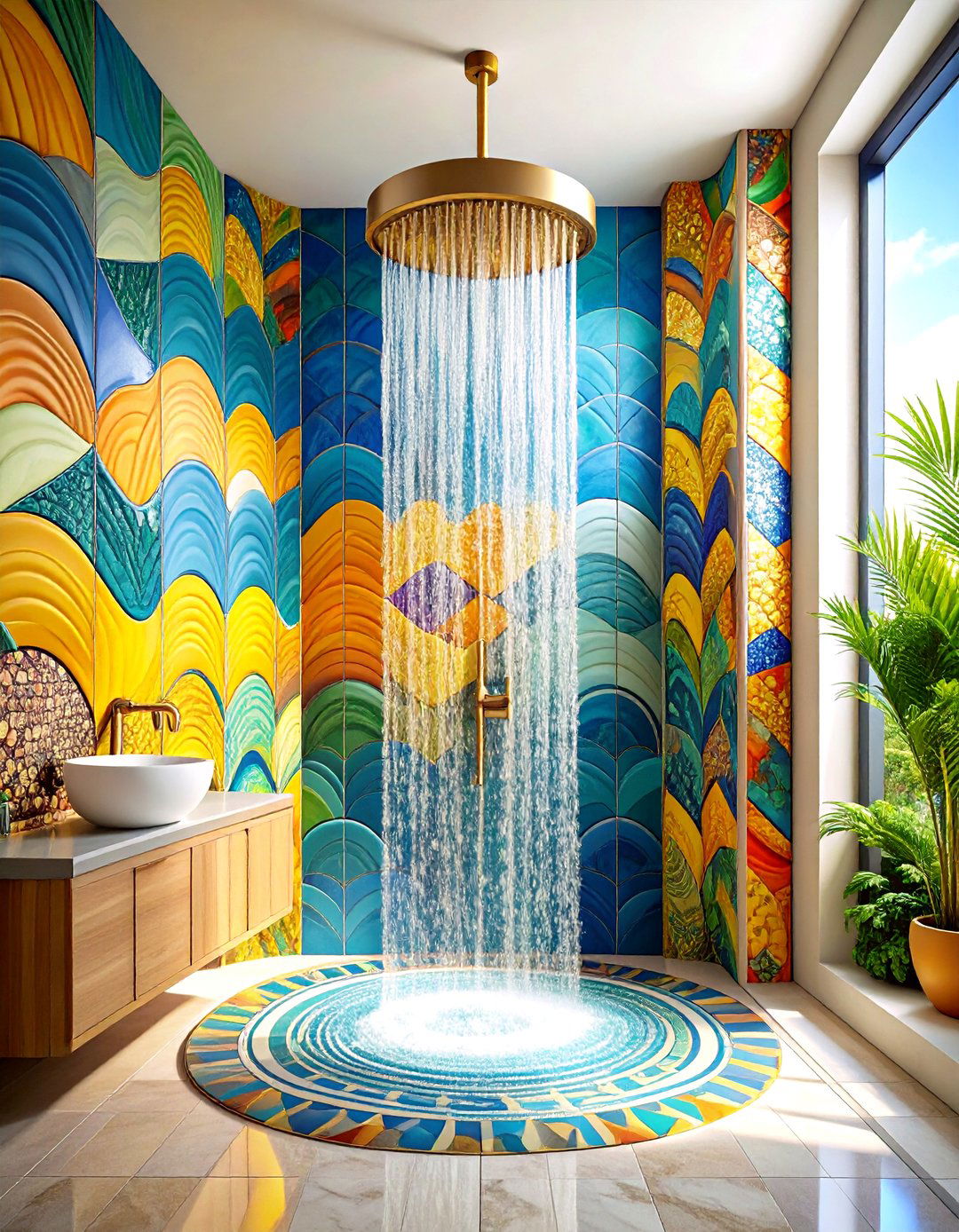
Three-dimensional tiles—such as wave patterns or sculpted reliefs—introduce sculptural depth and tactile intrigue to shower walls. These tiles, often porcelain or ceramic, range from subtle ripples to bold geometric reliefs. Positioned behind fixtures or in a full-wall installation, 3D tiles catch light and shadow, creating an ever-changing play of highlights throughout the day. While not recommended for floors due to potential tripping hazards, they excel as accent walls. To highlight the texture, pair with matte finishes on surrounding surfaces and choose monochromatic color schemes so that form, rather than hue, commands attention.
14. Diagonal Set (Diamond) Tiles
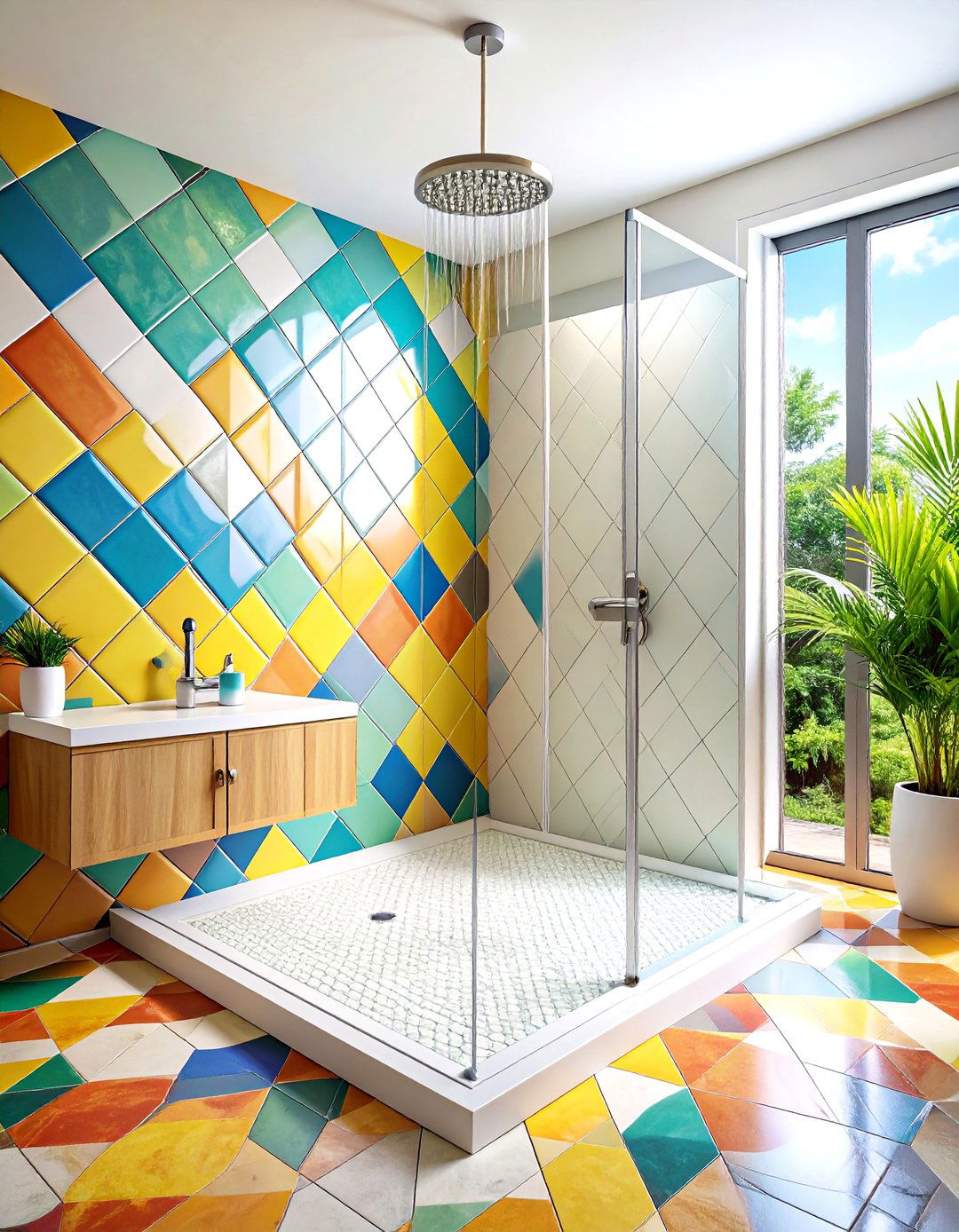
Arranging square tiles on the diagonal—also known as a diamond set—introduces a sophisticated, expansive feel to shower walls. This simple rotation transforms standard squares into dynamic shapes, guiding the eye upward and around the enclosure. Diagonal layouts work equally well with ceramic, porcelain, or natural stone tiles and can be executed at 45 degrees for a classic diamond effect. Grout lines become distinct graphic elements, so matching grout is preferred for a seamless look, while contrasting grout emphasizes the diamond geometry. This pattern elevates simple tile choices into a refined design statement.
15. Colorful Ceramic Tiles
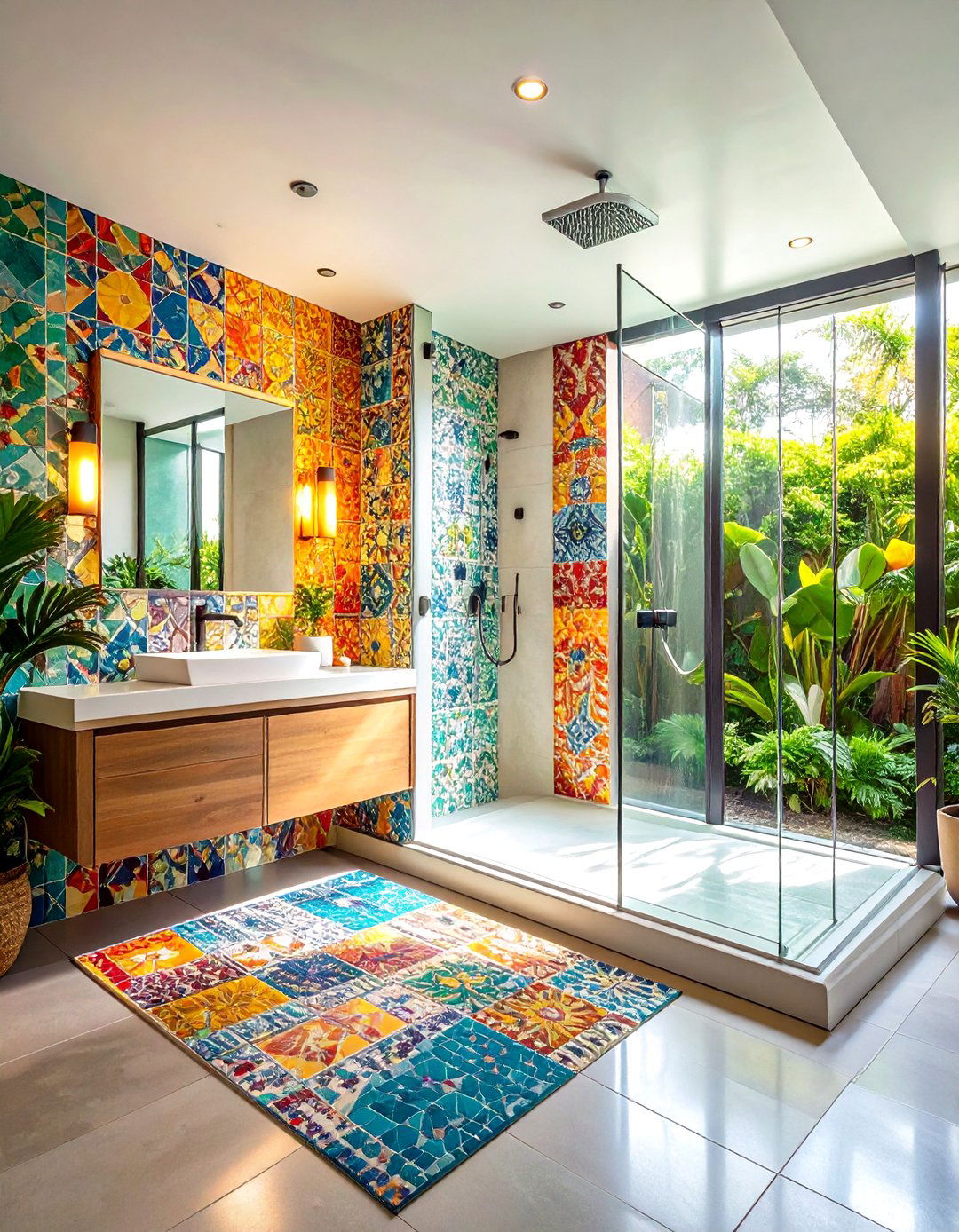
Vibrant ceramic tiles—whether glazed patterns or solid hues—inject personality and energy into walk-in showers. Color-blocked accent walls, multicolored mosaics, or hand-painted Moroccan motifs can transform the shower into an immersive jewel box. Ceramic’s gloss finish intensifies pigment depth, making even small bathrooms feel bold and playful. To balance high-impact color, pair with neutral tile on adjacent walls or floors. Built-in niches become ideal locations for accent tiles, framing toiletries in a burst of color. With endless shapes (hexagon, fish scale, arabesque) available, ceramic offers limitless creative expression for personalized shower designs.
16. Monochromatic Tone-on-Tone Tile
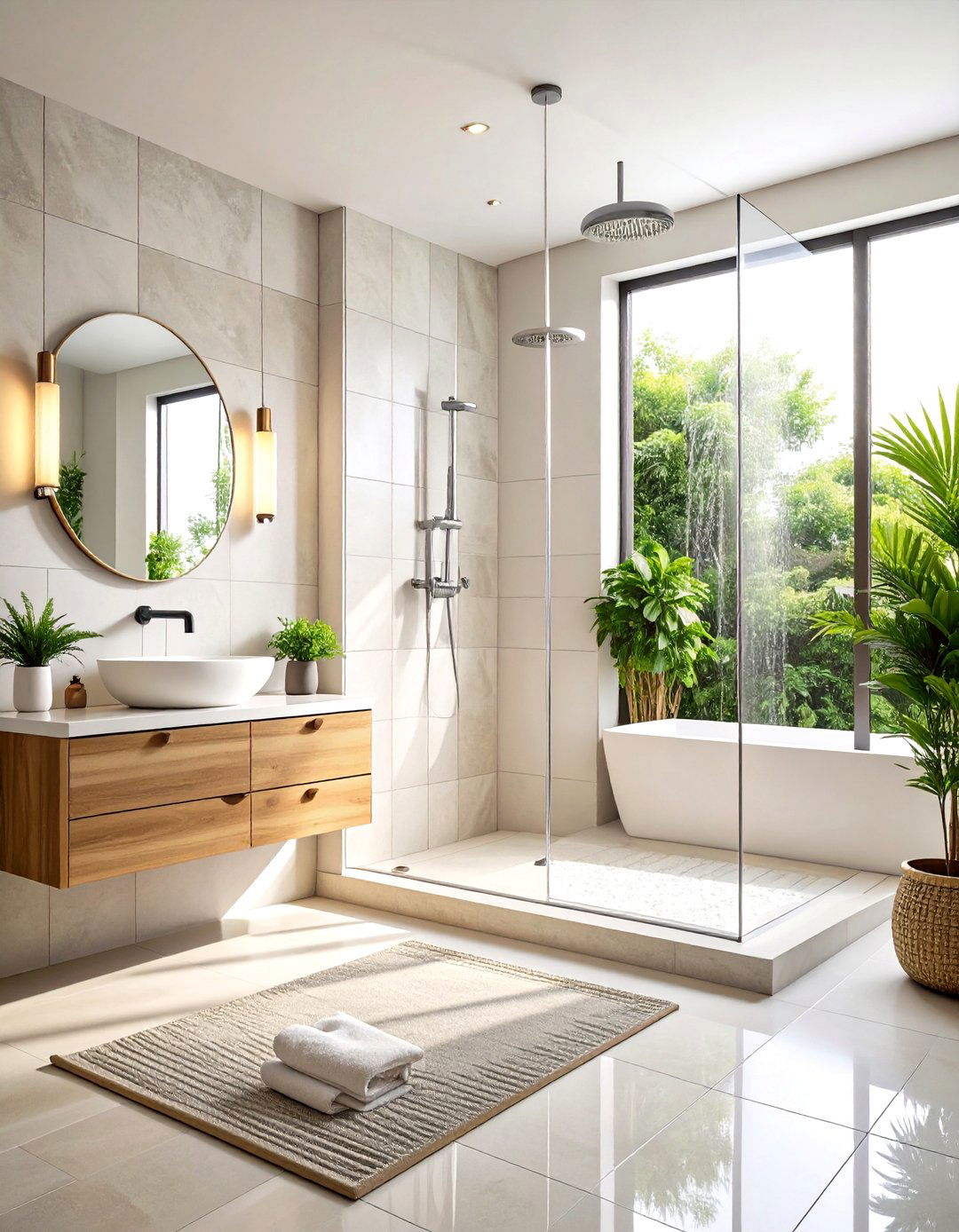
Using tiles in a single color family—such as varying shades of beige, taupe, or gray—creates a serene, spa-like atmosphere in walk-in showers. Selecting multiple tile formats—large slabs, small mosaics, and brick-size planks—in the same hue adds subtle depth without disrupting the calming palette. Matte and polished finishes combined in tone-on-tone arrangements heighten texture contrast. Monochromatic schemes allow fixtures, lighting, and accent elements (wood, metal) to stand out against a unified backdrop. This minimalist approach is perfect for creating a cohesive, restorative space that feels both modern and timeless.
17. Mixed Material Tile and Stone Accents
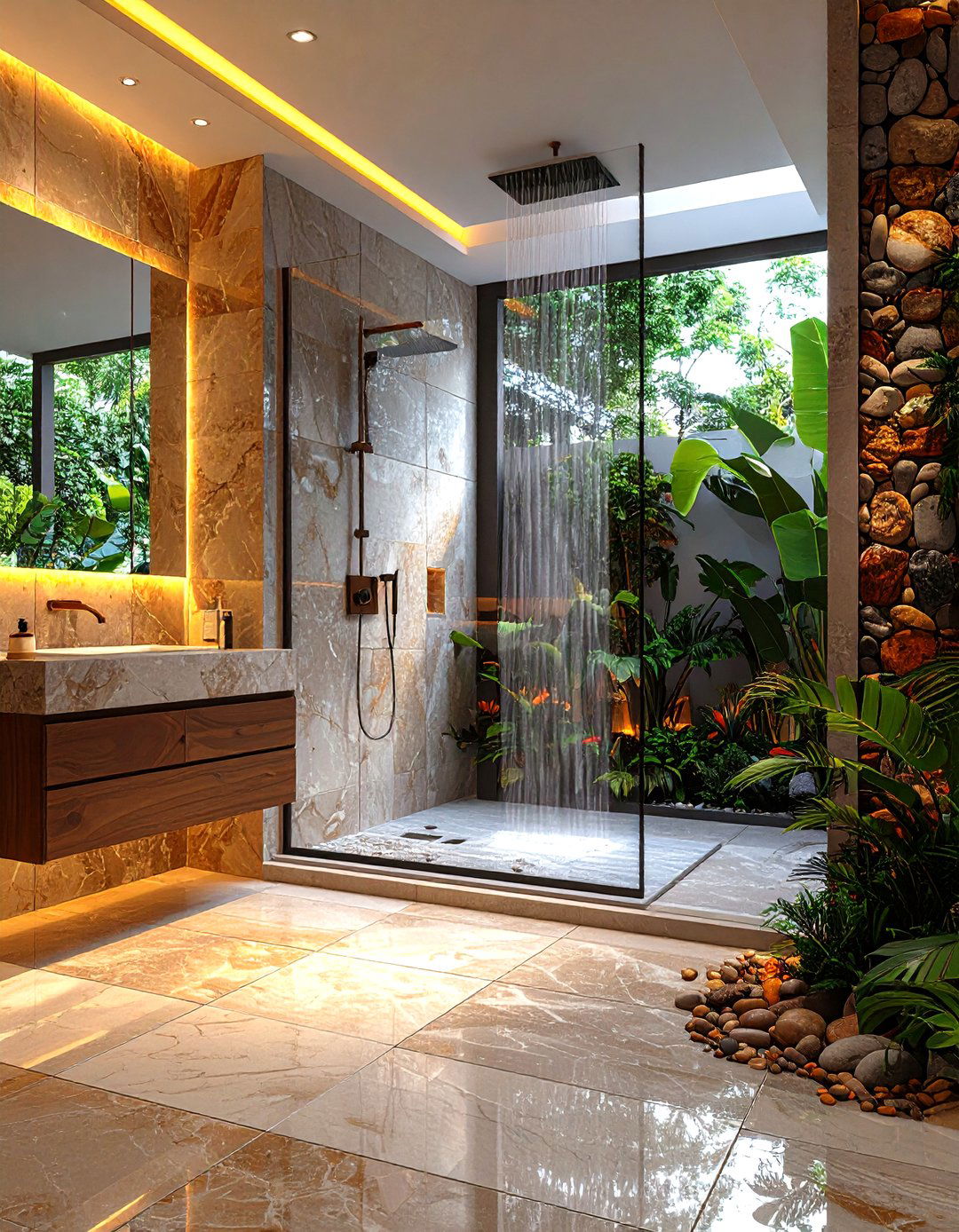
Combining porcelain or ceramic tiles with natural stone mosaics introduces layered texture and visual interest to walk-in showers. For example, framing a marble mosaic border with large porcelain slabs integrates luxury without overextending budget or maintenance needs. Alternating tile materials—such as a central stone medallion flanked by ceramic subway tile—highlights shower fixtures and niches. This hybrid approach balances the durability and cost-effectiveness of porcelain with the unique veining and warmth of natural stone, resulting in a custom, high-low design that elevates the shower into a gallery-worthy installation.
18. Floor-to-Ceiling Tile
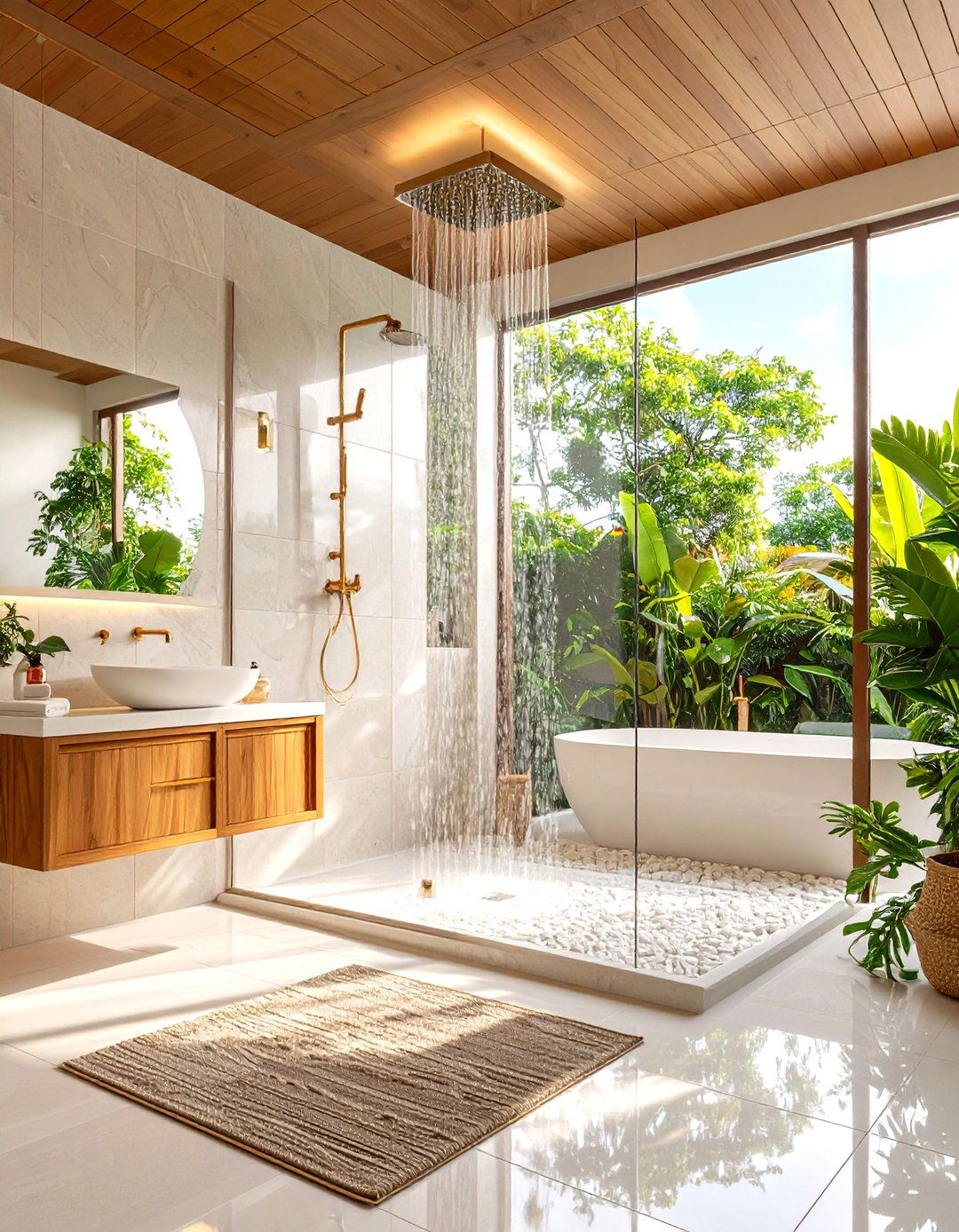
Extending tile from the shower floor all the way up to the ceiling produces a dramatic, enveloping effect that modernizes any walk-in enclosure. This unbroken surface highlights the tile’s natural pattern—whether subtle marble veins or bold geometrics—and eradicates visual breaks that can make a stall feel chopped. Floor-to-ceiling tile installations amplify verticality, drawing the eye upward and making ceilings appear taller. For seamless continuity, match grout lines and tile format throughout. The result is a monolithic masterpiece that’s both strikingly modern and elegantly simple.
19. Subway Tile with Dark Grout
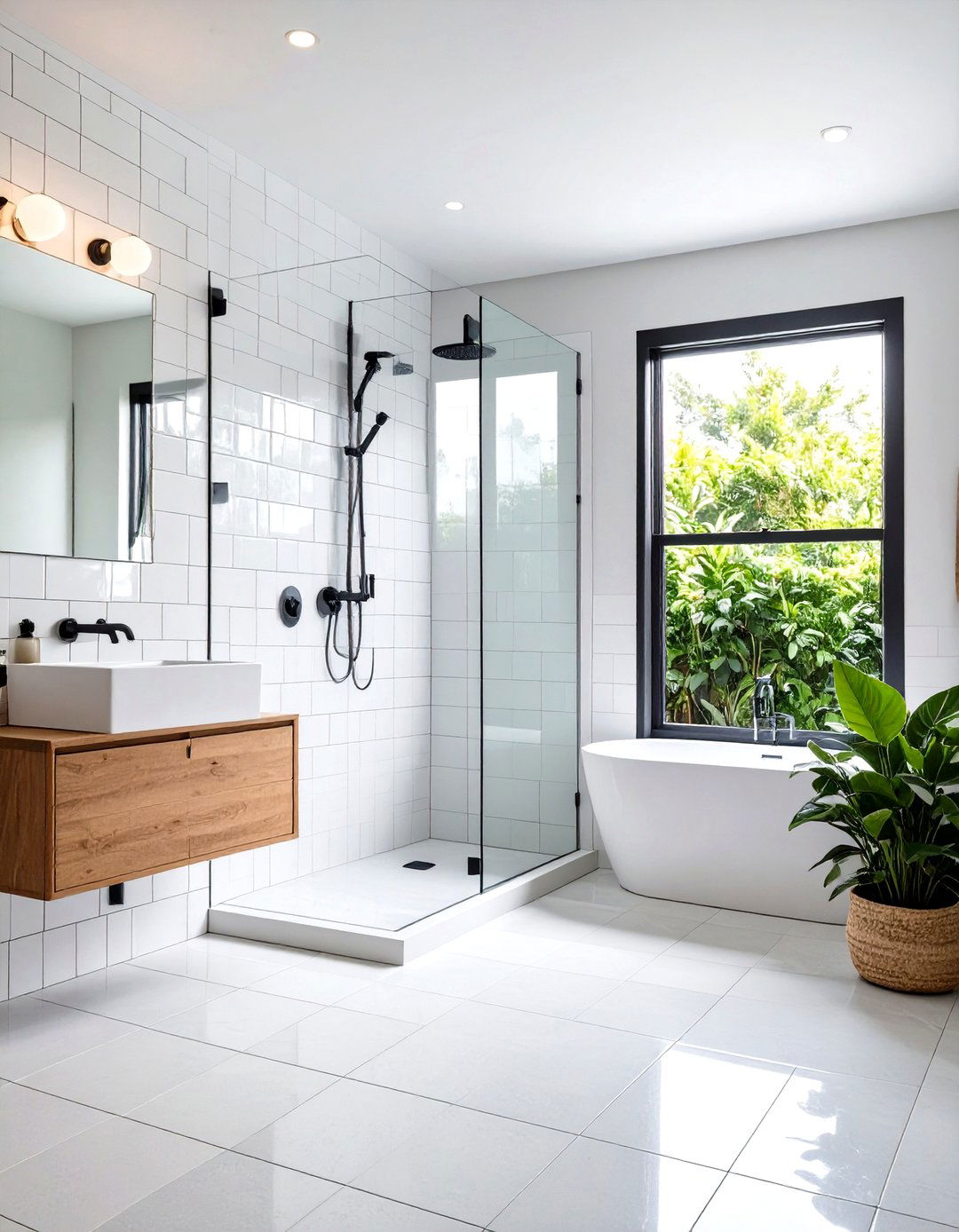
Subway tile gains contemporary flair when paired with charcoal or black grout, creating a graphic grid that adds depth and clarity to shower walls. The dark contrast emphasizes each tile’s outline, turning a classic running bond into a bold statement. Ideal in industrial or loft-style bathrooms, this pairing complements matte-black fixtures and minimalist hardware. Because dark grout masks discoloration better than lighter shades, it’s also a practical choice for high-use showers. Whether applied over the entire stall or confined to an accent wall, dark‐grouted subway tiles bridge traditional form with modern edge.
20. Patterned Encaustic Cement Tiles
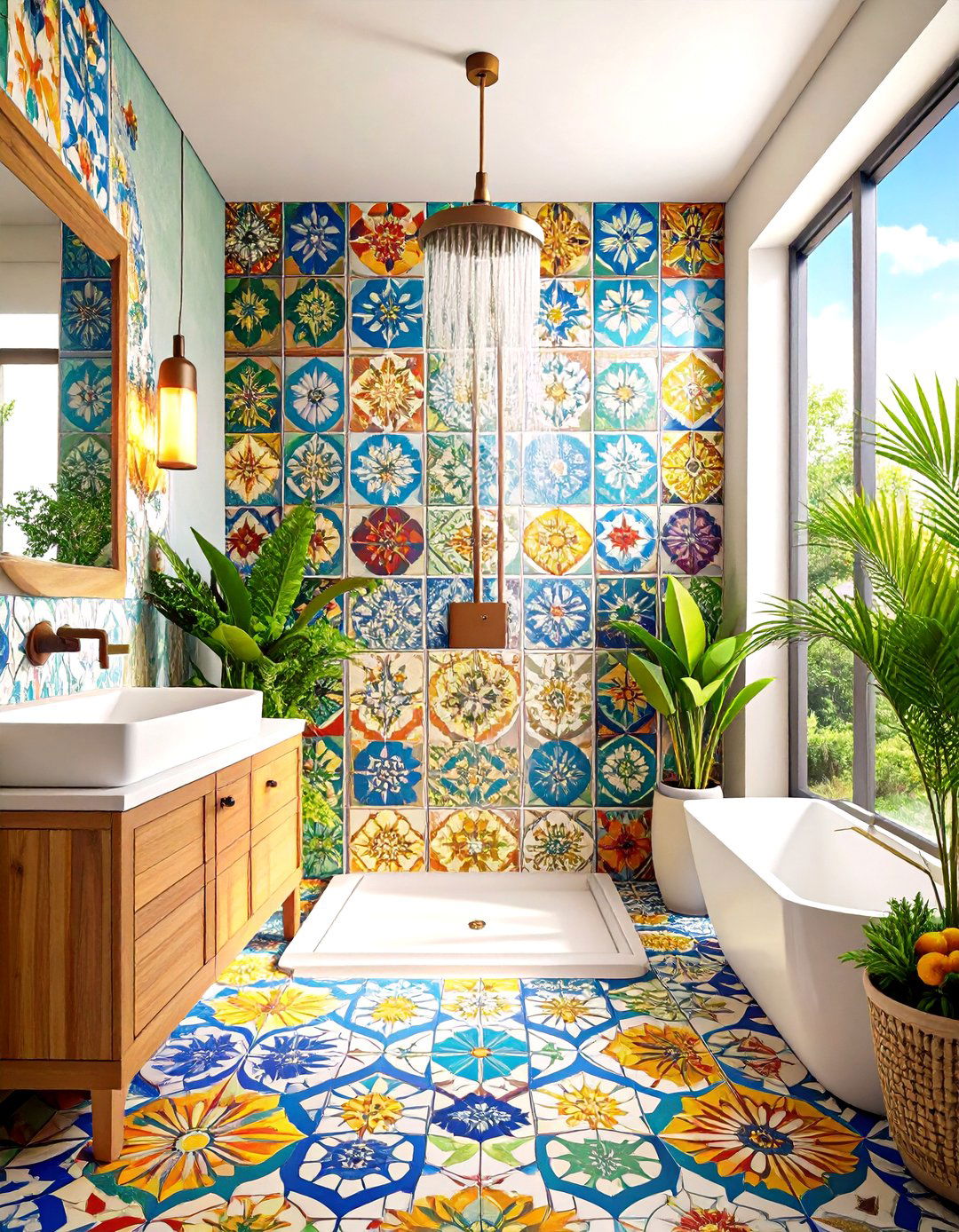
Patterned encaustic cement tiles introduce artisanal color and historic charm to walk-in showers, making each wall feel like hand-crafted artwork. Often featuring repeating motifs—geometric, floral, or Moorish—encaustic tiles are pigmented through the tile’s body, ensuring enduring color. While cement tiles require sealing and gentle cleaning, their vibrant patterns and matte texture create a tactile, heritage-infused environment. Use them for the entire enclosure for maximum impact or reserve them for a half-wall or niche to balance bold design with neutral surroundings. Encaustic tiles celebrate craftsmanship and elevate showers into cultural statements.
Conclusion:
From enduring classics like subway and hexagon formats to artisan-forward options such as zellige and encaustic patterns, walk-in shower tile trends span every style and budget. Large-format and floor-to-ceiling installations streamline maintenance and amplify space, while textured and mosaic designs invite hands-on visual exploration. Whether you favor a minimalist monochromatic palette, bold color accents, or a fusion of materials, today’s tile innovations empower you to customize your shower into a personal sanctuary. By understanding each tile’s unique installation and care requirements, you can select the perfect finish to achieve both lasting beauty and practicality in your next bathroom renovation.


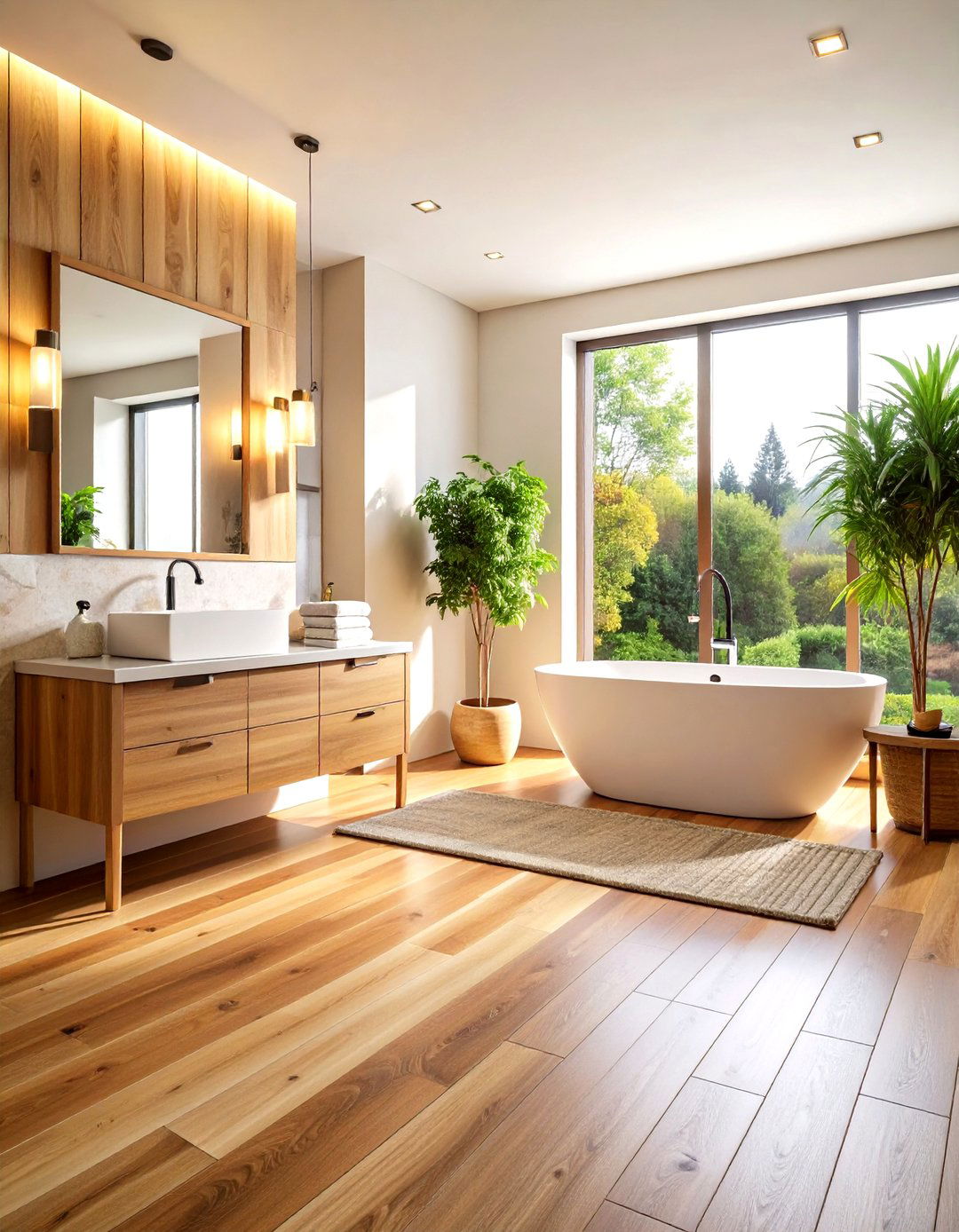

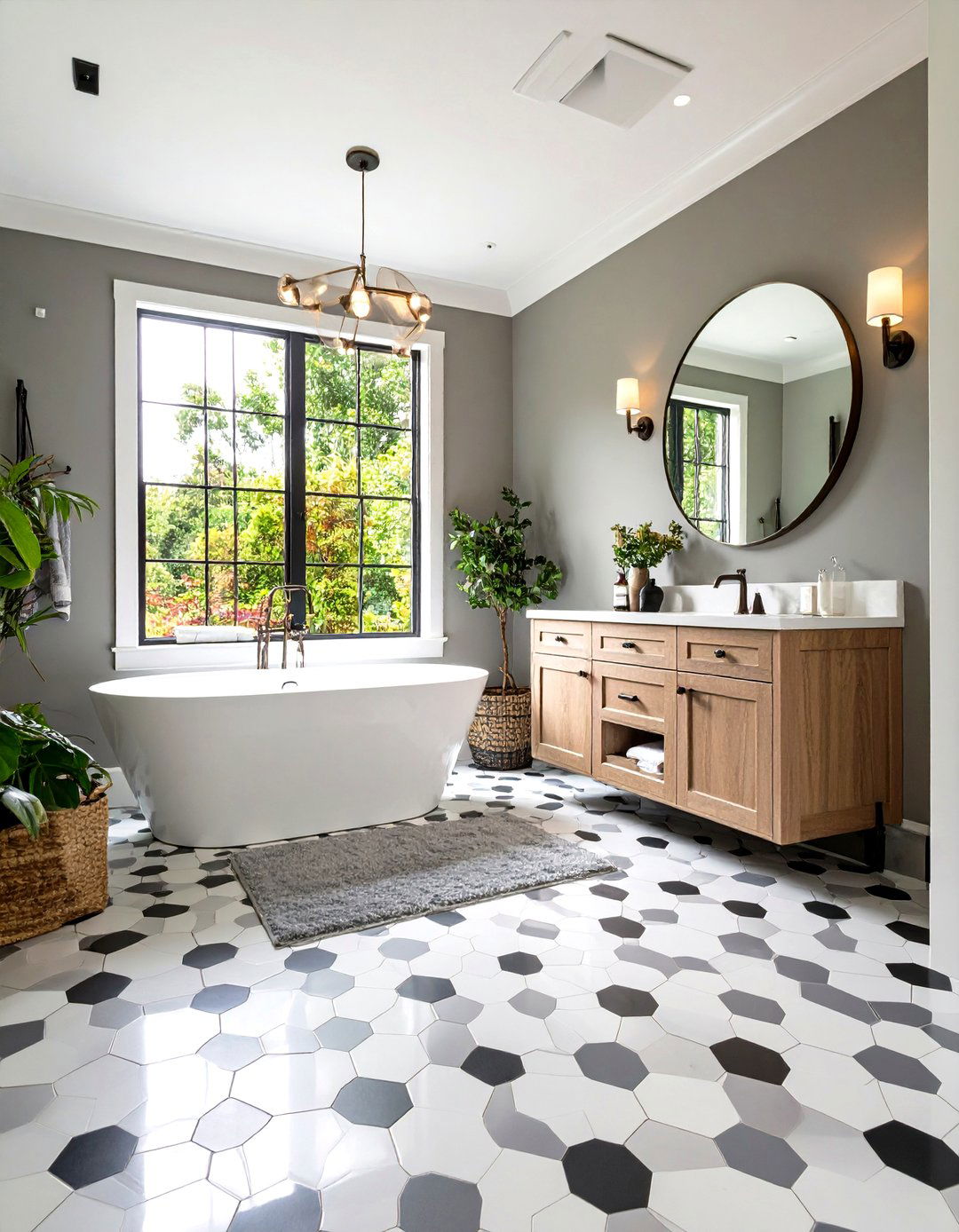
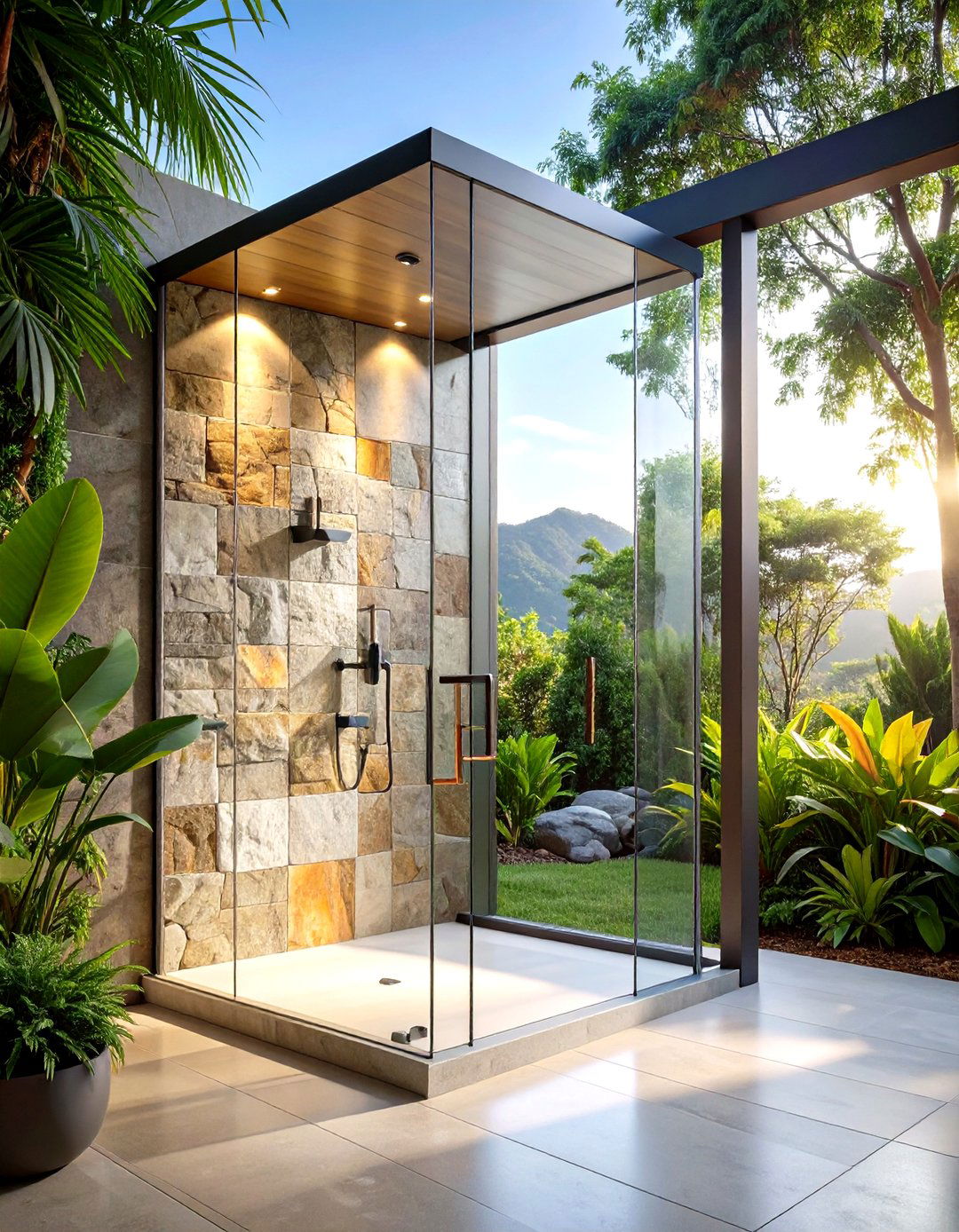
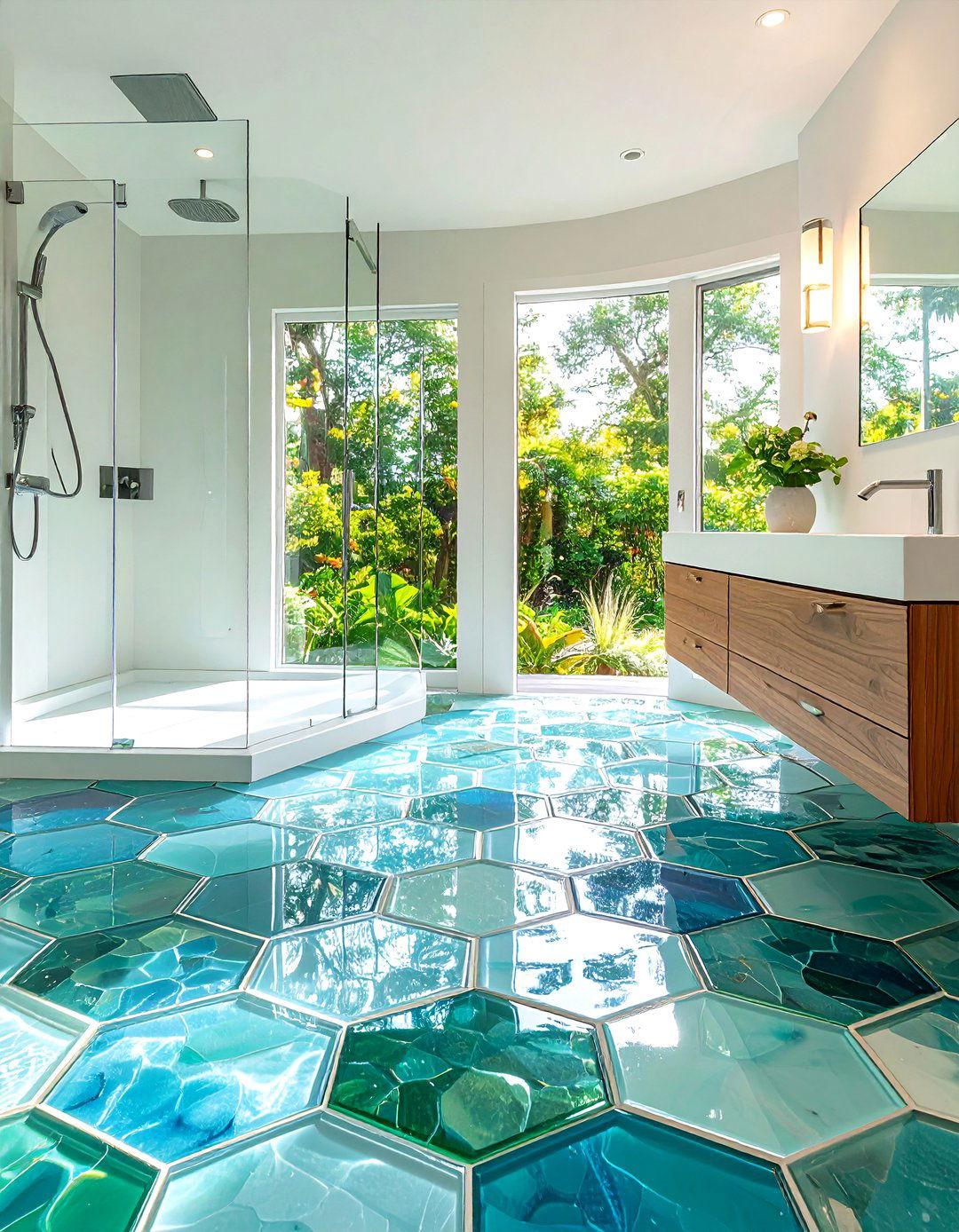

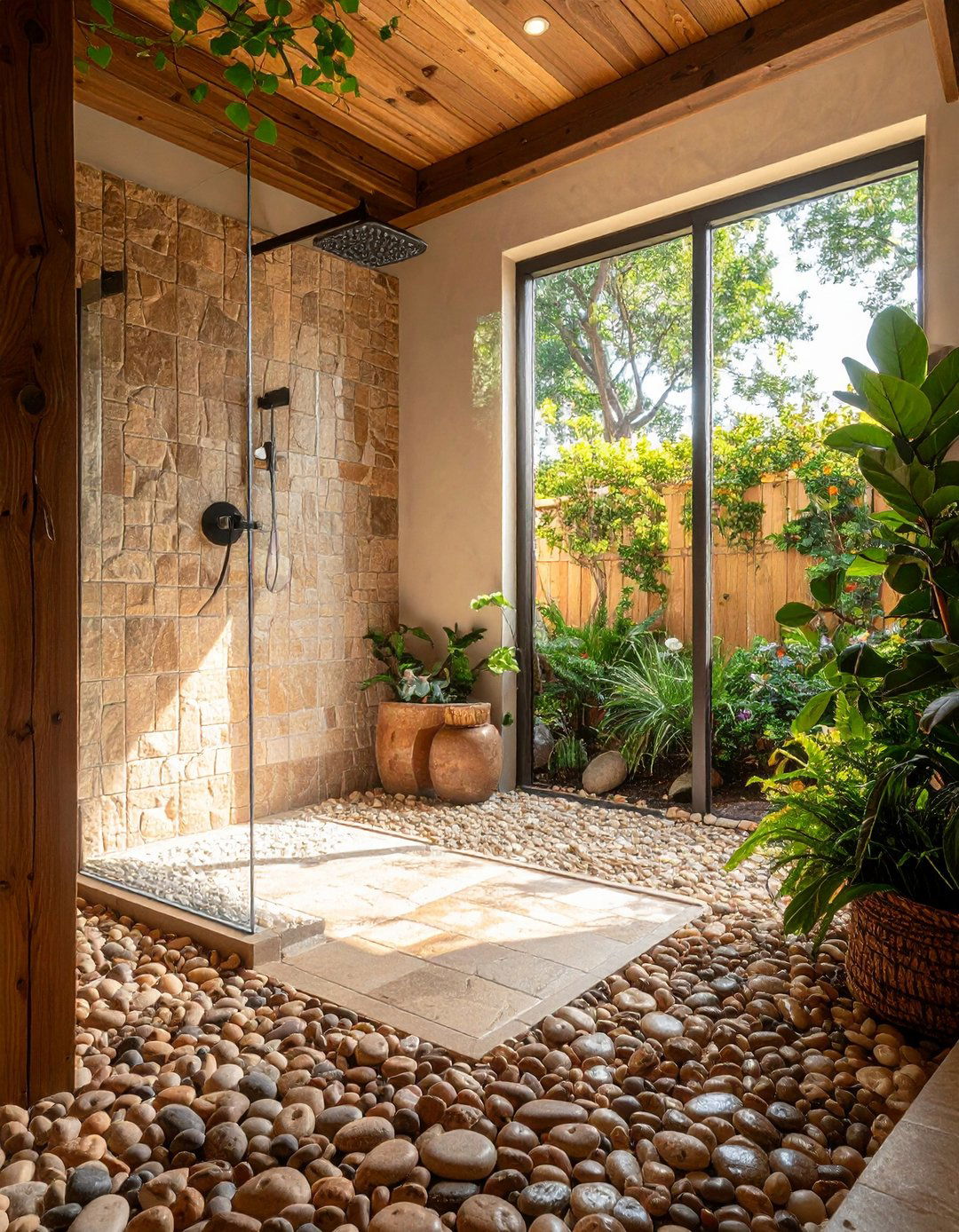


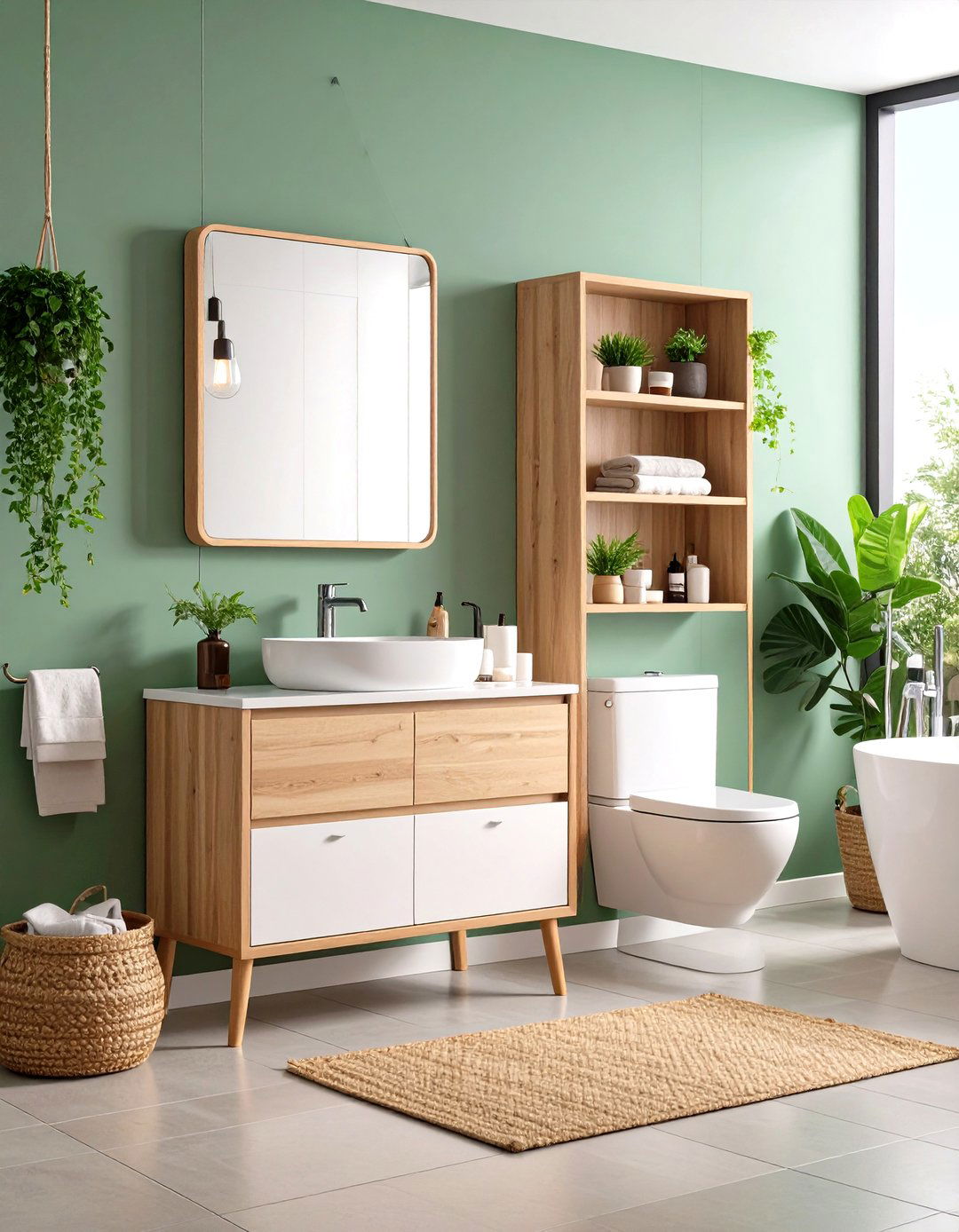

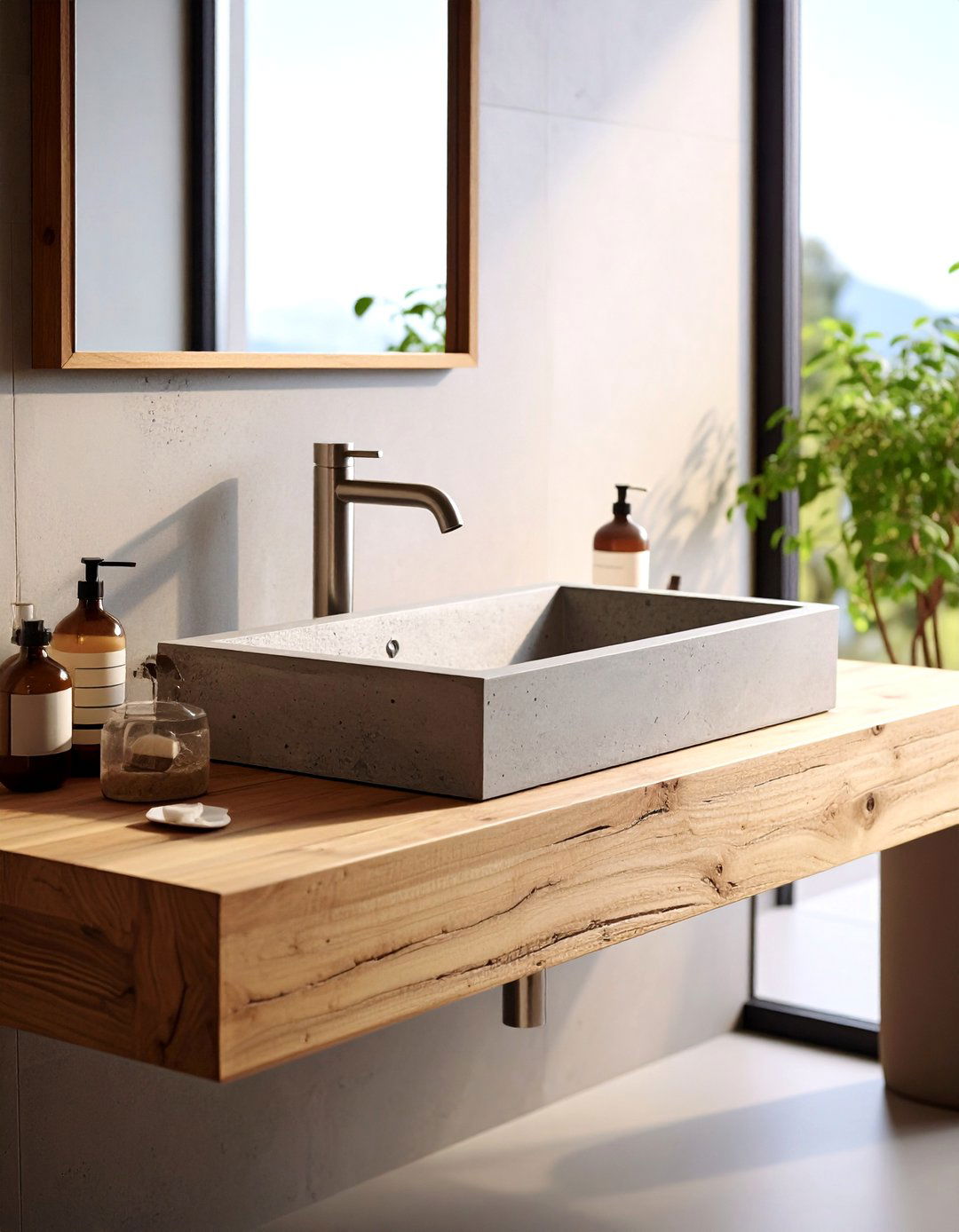
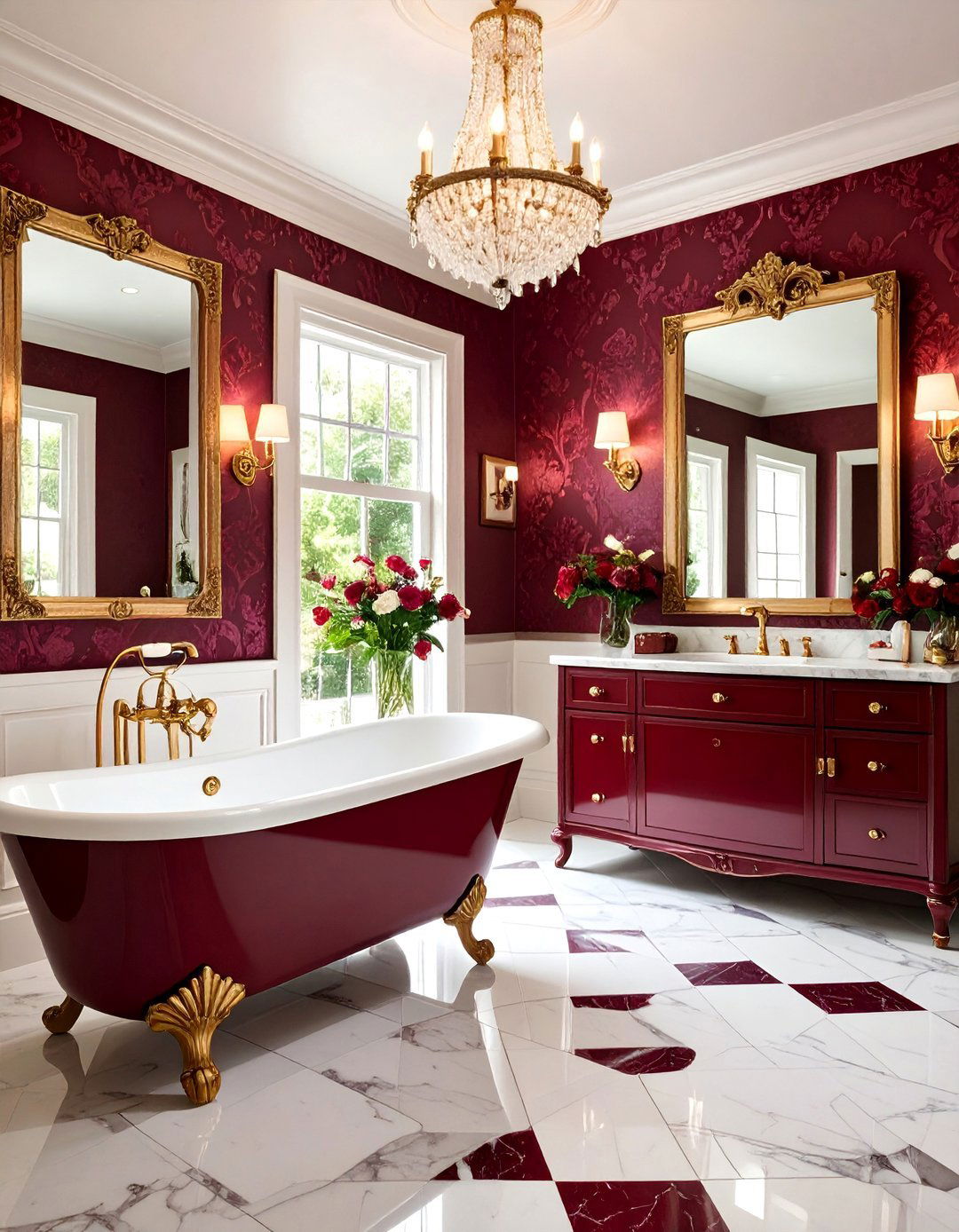

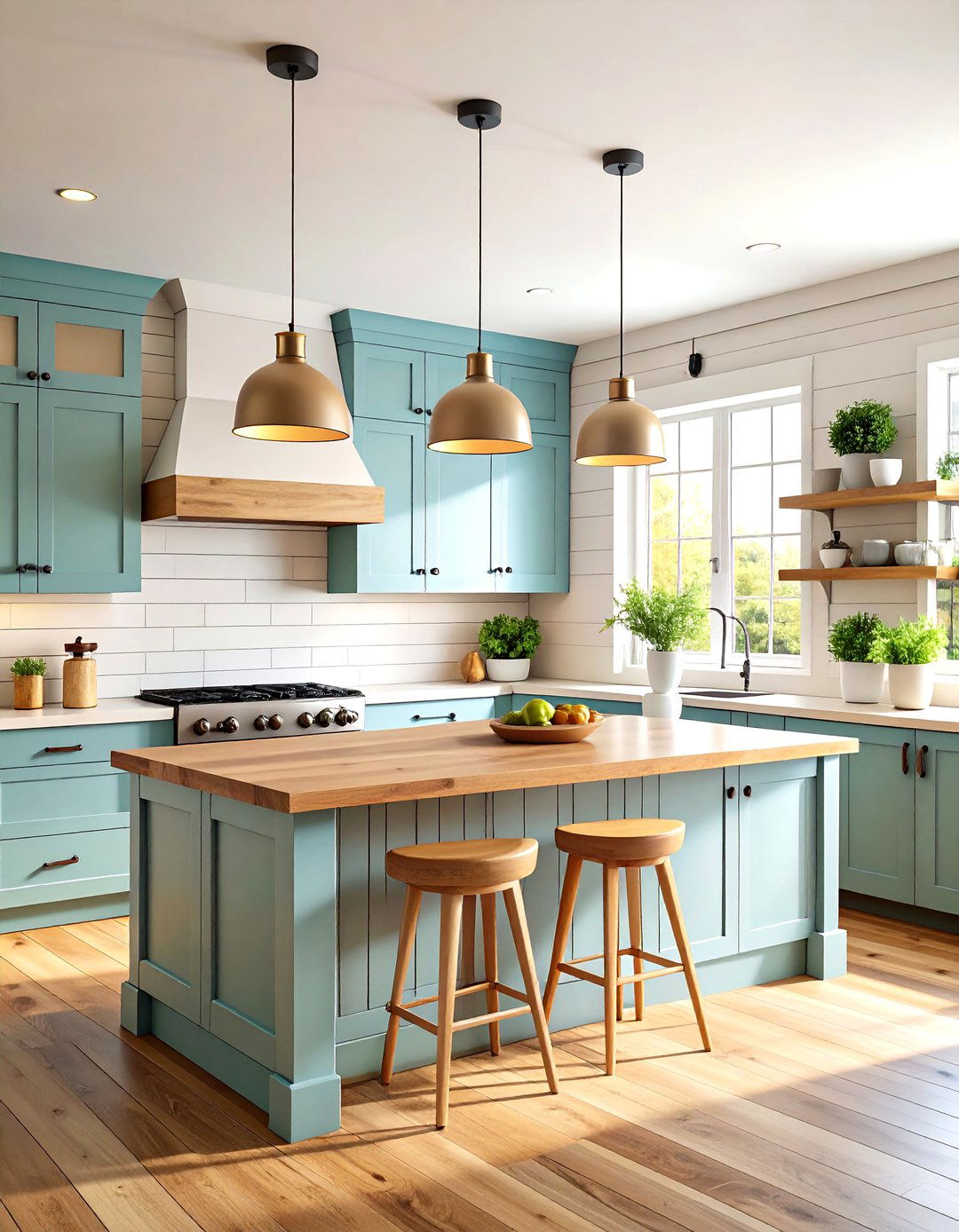
Leave a Reply